Home / Deciding SN1/SN2/E1/E2 (1) – The Substrate
SN1/SN2/E1/E2 Decision
Deciding SN1/SN2/E1/E2 (1) – The Substrate
Last updated: February 28th, 2025 |
The Role of The Substrate In Substitution & Elimination Reaction: SN2 vs E1/SN1
- Deciding whether a reaction is SN1/SN2/E1/E2 first of all requires understanding the bonds that form and break in each of these four reactions and the key features of their mechanisms (Review here – SN1 / SN2 / E1 / E2)
- Primary, secondary, tertiary (and methyl) carbons attached to good leaving groups (such as alkyl halides and sulfonates) are good substrates for SN1/SN2/E1/E2 reactions. If this is not clear, review here
- If the alkyl carbon is primary, the lack of steric hindrance makes SN2 likely and the lack of carbocation stability makes SN1 and E1 unlikely. The main exception is with strong, bulky bases (E2).
- If the alkyl carbon is tertiary, it will not be SN2. More information is required to determine exactly which reaction will happen. Depending on the identity of the base (strong or weak) it may be SN1/E1 (weak base) or E2 (strong base)
- Secondary alkyl halides can potentially undergo all four reactions and require analyzing the nucleophile / base. (See here) as well as possibly the solvent and temperature.
- Alcohols can also be substrates for SN1/SN2/E1/E2 reactions, but require acidic conditions to convert OH into a good leaving group (OH2+ ). Basic conditions convert alcohols into alkoxides (RO– ) which are good nucleophiles.
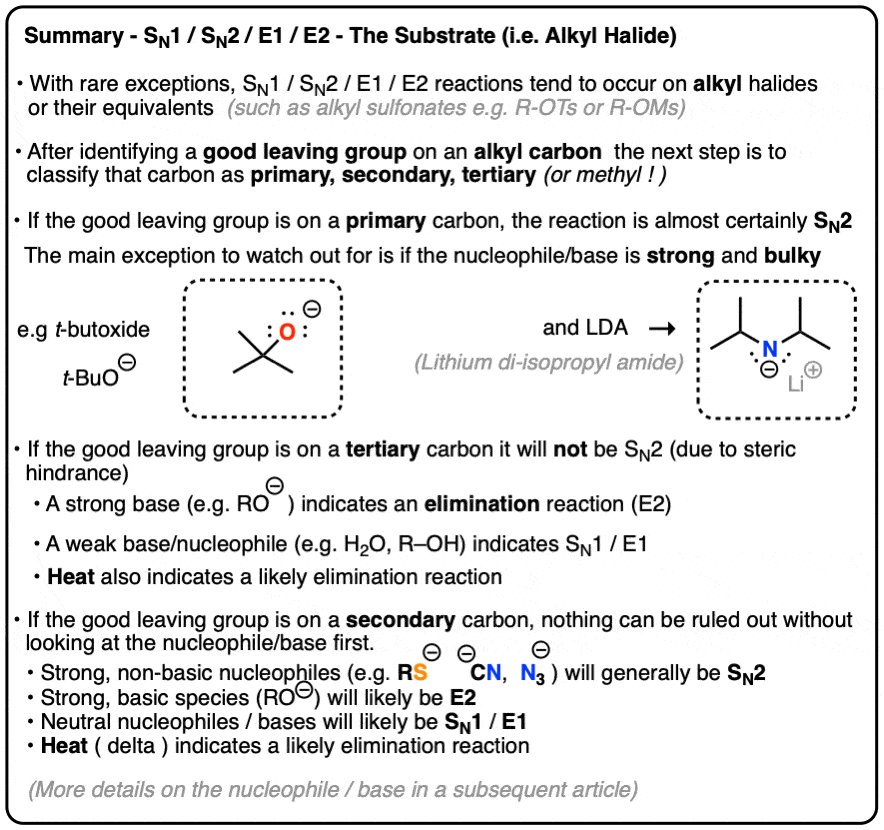
Table of Contents
-
- Step One: Determine If The Substrate is Primary, Secondary, or Tertiary
- Let’s Look At Some Example Reactions
- So The Substrate is Primary. Now What?
- What if It’s Tertiary?
- The Problem Child: Secondary Alkyl Halides
- A Look Ahead – Evaluating Nucleophile/Base, Solvent, Temperature
- Some Examples With Alcohols
- Summary
- Notes
- Quiz Yourself!
- (Advanced) References and Further Reading
1. First Off: Determine If The Substrate Is Primary, Secondary or Tertiary
What’s the very first step in deciding whether a reaction goes through SN1, SN2, E1 or E2?
- The very first thing is to identify a good leaving group such as Cl, Br, I, or OTs/OMs! (For a refresher, see this previous post – How To Tell Where Substitution and Elimination Reactions Will Happen)
- The other key thing to note is that with very few exceptions, substitution and elimination reactions only happen on alkyl (i.e. sp3-hybridized) carbons.
So for our purposes, in order for SN1/SN2/E1/E2 to take place, we generally need to see an alkyl halide (or alkyl sulfonates, such as tosylates and mesylates – See post: Tosylates and Mesylates).
Once you’ve identified an alkyl halide, the next step is to determine whether it is primary, secondary, or tertiary.
Try it for yourself with this quick quiz!
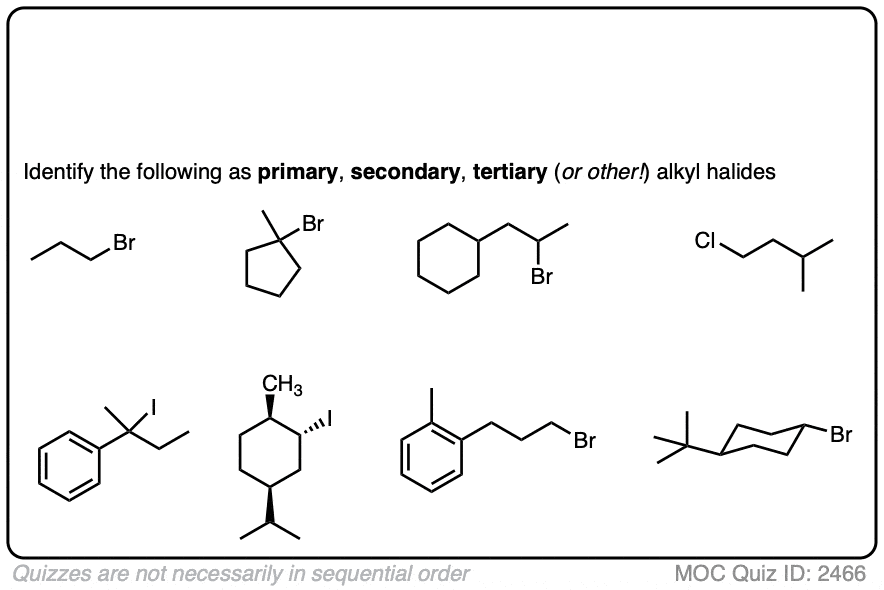 Click to Flip
Click to Flip
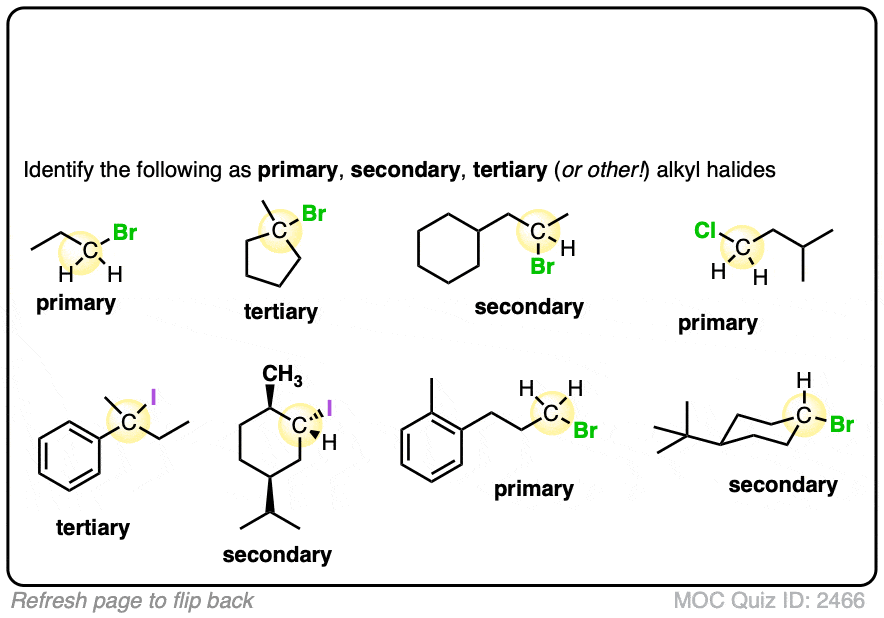
If these are difficult for you, then back up and have another look at this post (See article – Primary, Secondary, Tertiary, Quaternary in Organic Chemistry)
If this is too easy, then here’s a (slightly) more difficult set.
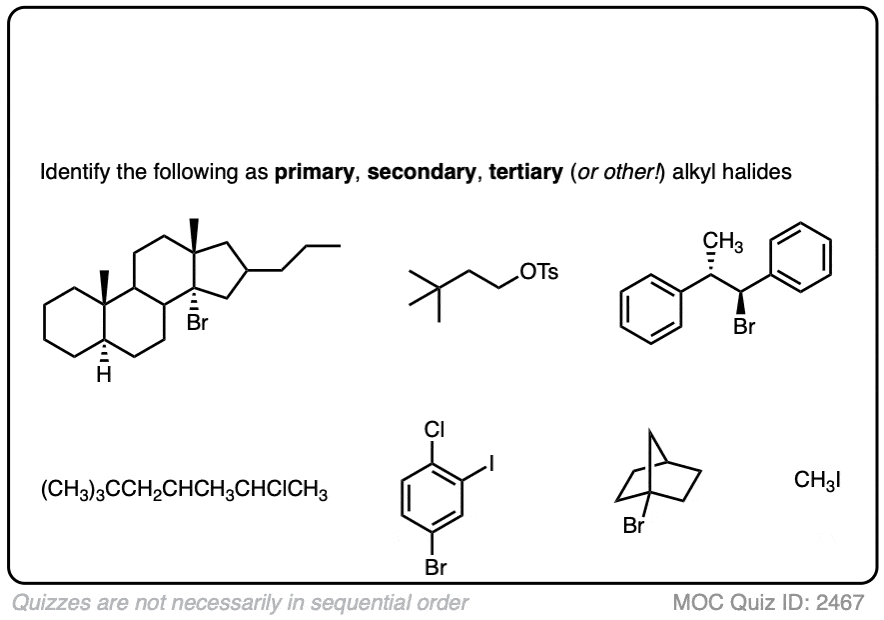 Click to Flip
Click to Flip
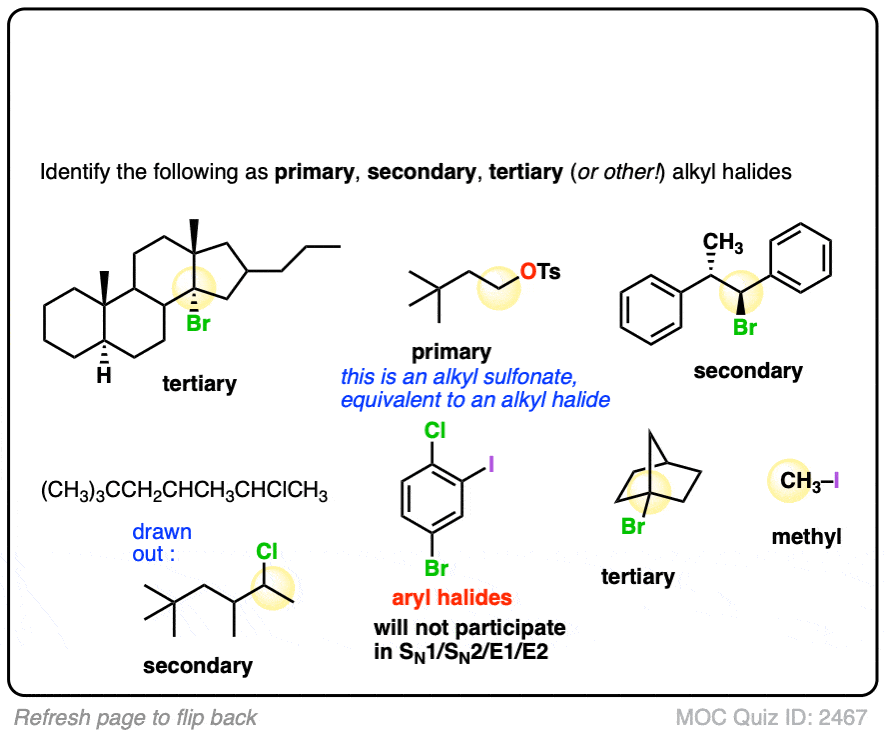
Note that sometimes these reactions are drawn out with reactions that won’t work. with the intention to test your understanding of mechanisms. If you see a question involving an alkenyl halide, your job is to figure out if it is put in there as a trick question, or if it qualifies as one of the (rare) exceptions to the “only alkyl carbons” rule. (The main exception is formation of alkynes via double elimination – see article)
2. Looking At Some Reactions
Once you can classify alkyl halides as primary, secondary, tertiary (or methyl!) the next step is to do it in the context of several reactions, where it’s not uncommon to see things drawn up a little unconventionally.
Before asking any other questions, look at the reactions below and see if you can identify potential substrates for SN1/SN2/E1/E2 reactions.
Let’s start with a fairly easy one. Identify primary, secondary, and tertiary:
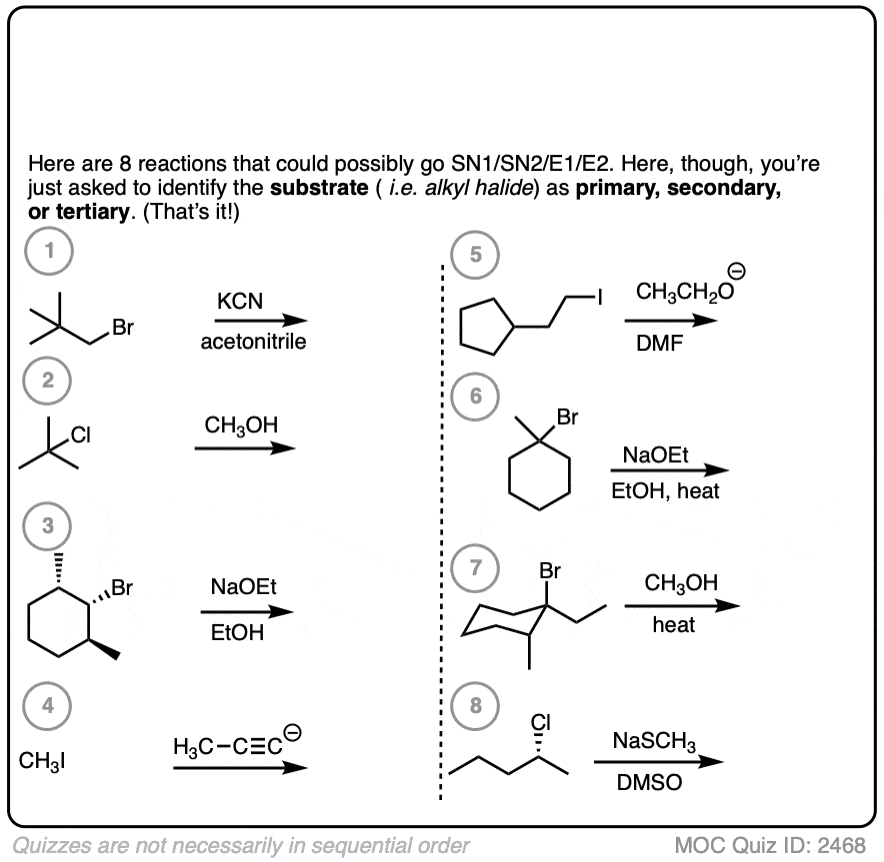 Click to Flip
Click to Flip
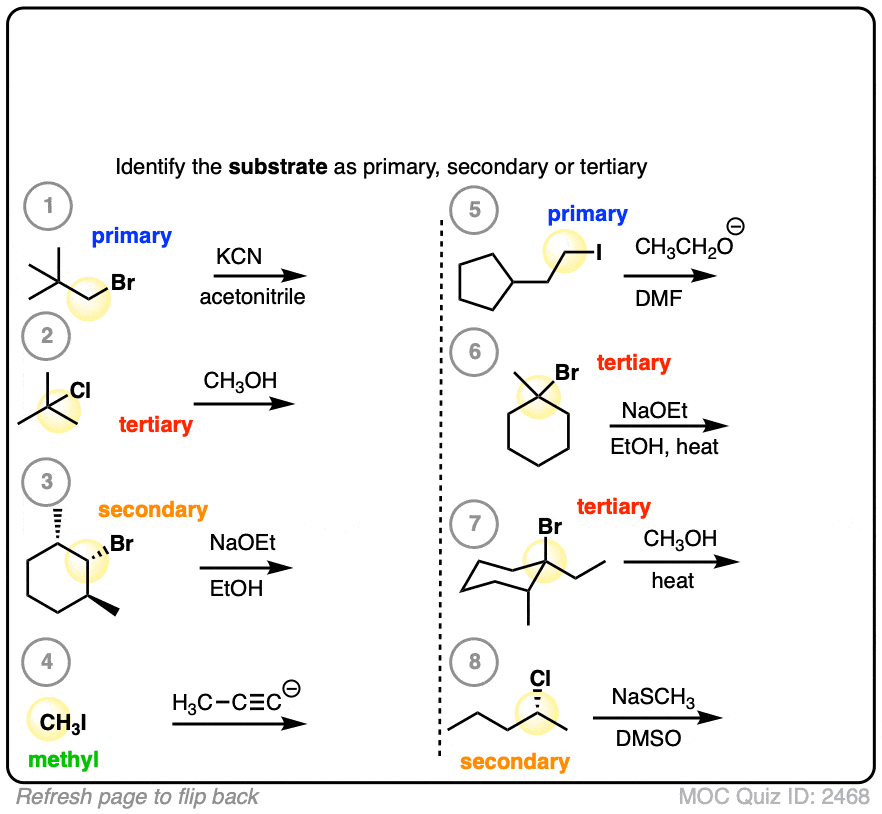
This one is slightly more difficult.
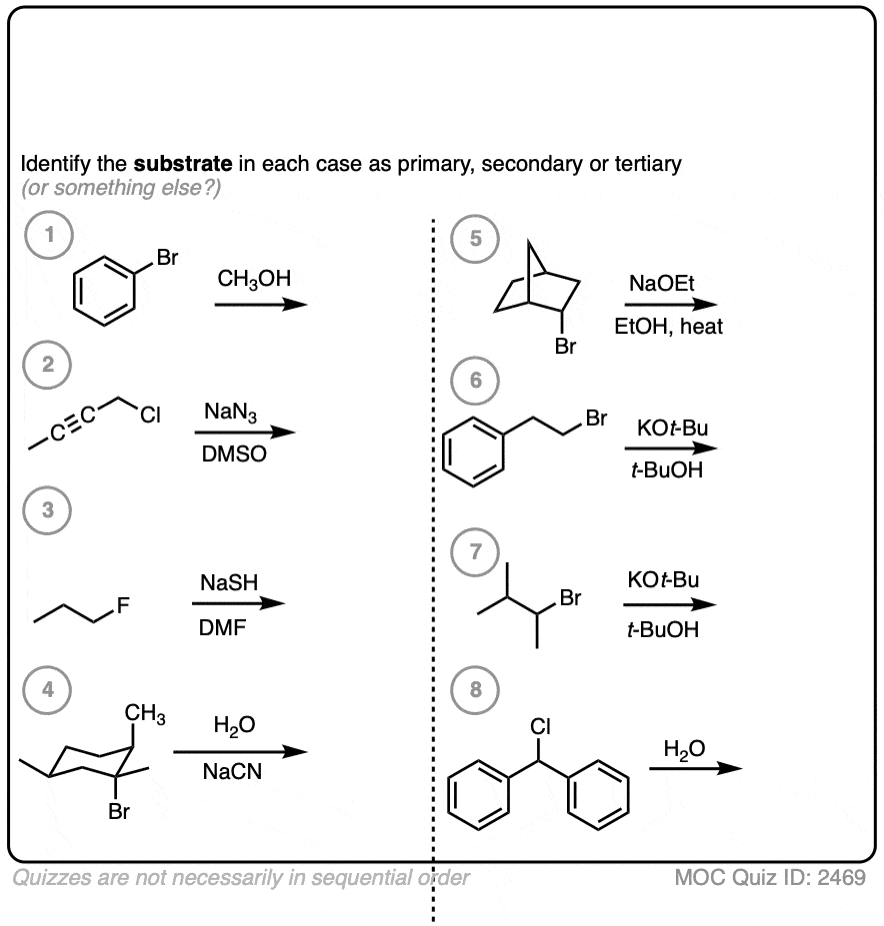 Click to Flip
Click to Flip
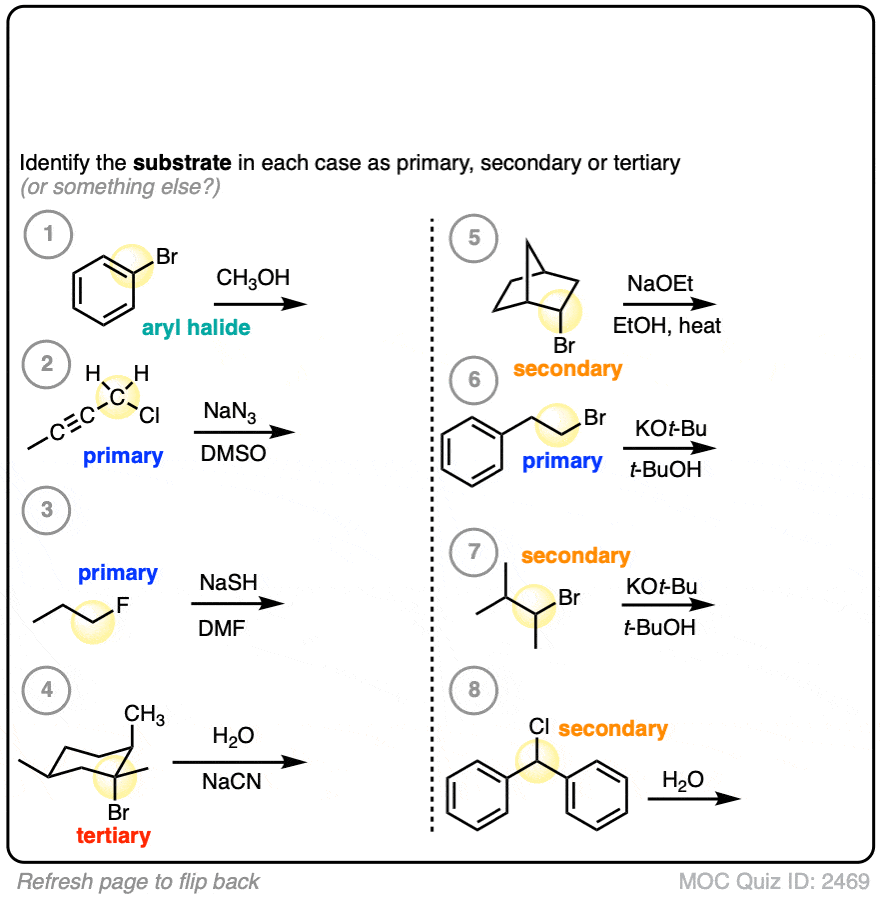
Finally, this has some harder examples.
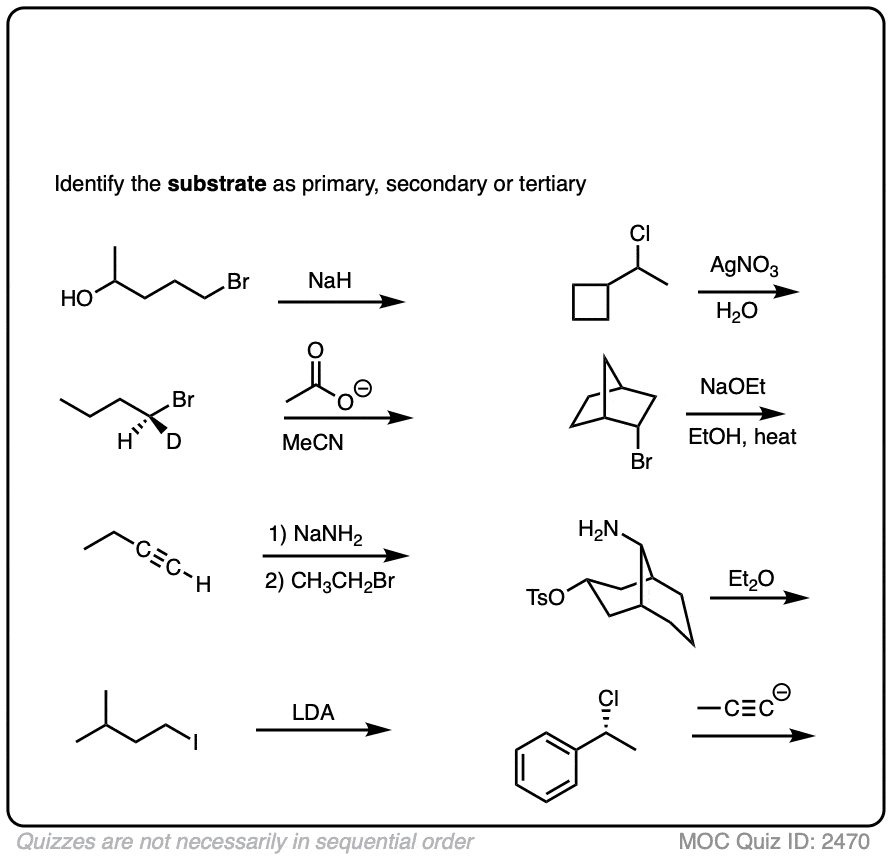 Click to Flip
Click to Flip
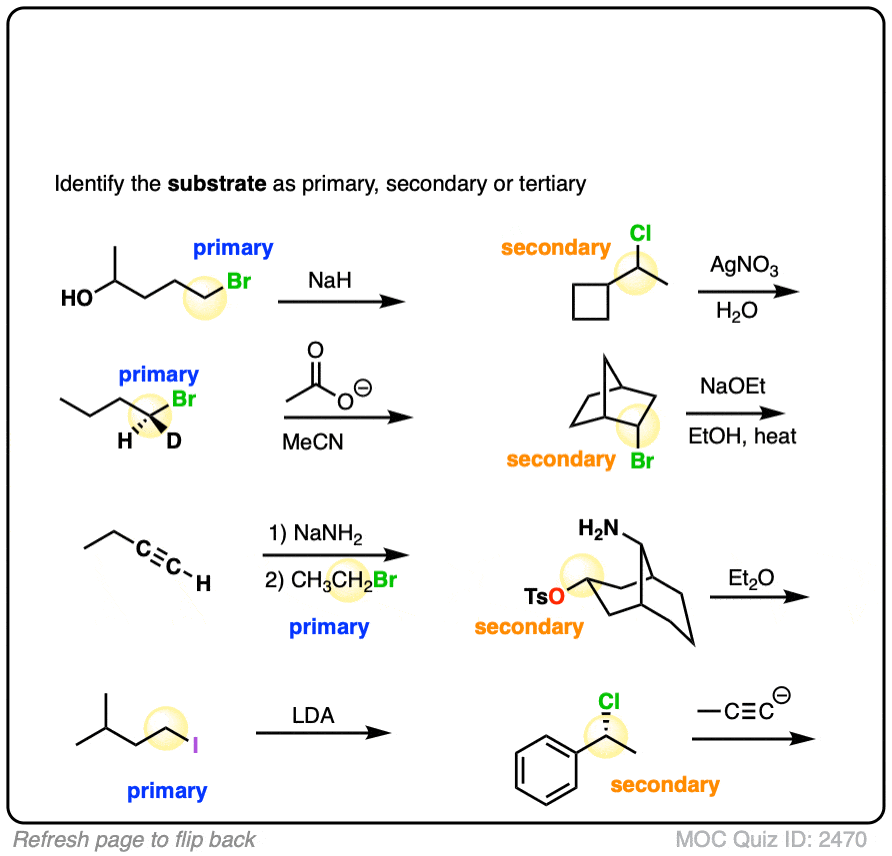
If you’ve looked at the reaction and found a primary, secondary, tertiary or methyl halide (or tosylate/mesylate, but not fluoride), then you are potentially looking at a substitution or elimination reaction.
If there’s no alkyl halide, then it’s very likely there’s no substitution or elimination reaction!
3. So The Alkyl Halide Is Primary – Now What?
All right. Let’s say we’ve identified our alkyl halide as primary.
Now what do we do?
We can make a confident prediction. When the substrate is primary (or methyl), expect SN2
These reactions will almost certainly not be SN1 or E1. [Note 1] That’s because the first step of SN1/E1 is loss of a leaving group to form a carbocation, and primary carbocations tend to be unstable. (See article: Carbocation Stability)
The next step is to predict the product. To do this, we:
- look for a good nucleophile, then
- apply the key pattern for the SN2 reaction (form C-Nu, break C-LG)
- invert the chiral center if there is one (rare for primary)
Also, it might help to recall the identities of common polar aprotic solvents such as DMF, DMSO, and acetonitrile (MeCN). These will affect the rate of substitution reactions but they are not nucleophiles. (See article – All About Solvents)
Now let’s put it into action. Assuming these reactions are SN2, draw the products.
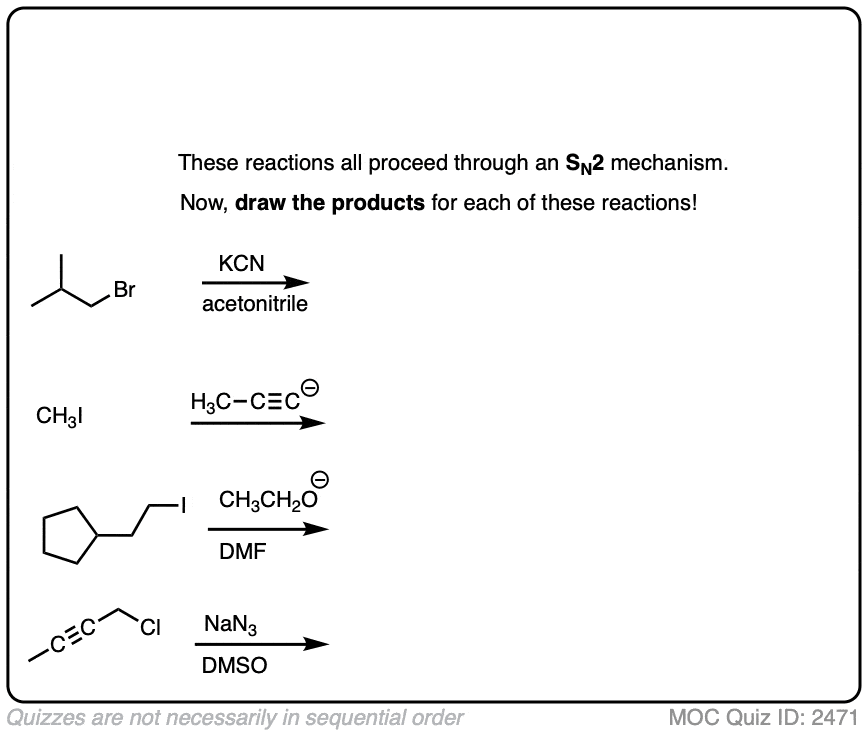 Click to Flip
Click to Flip
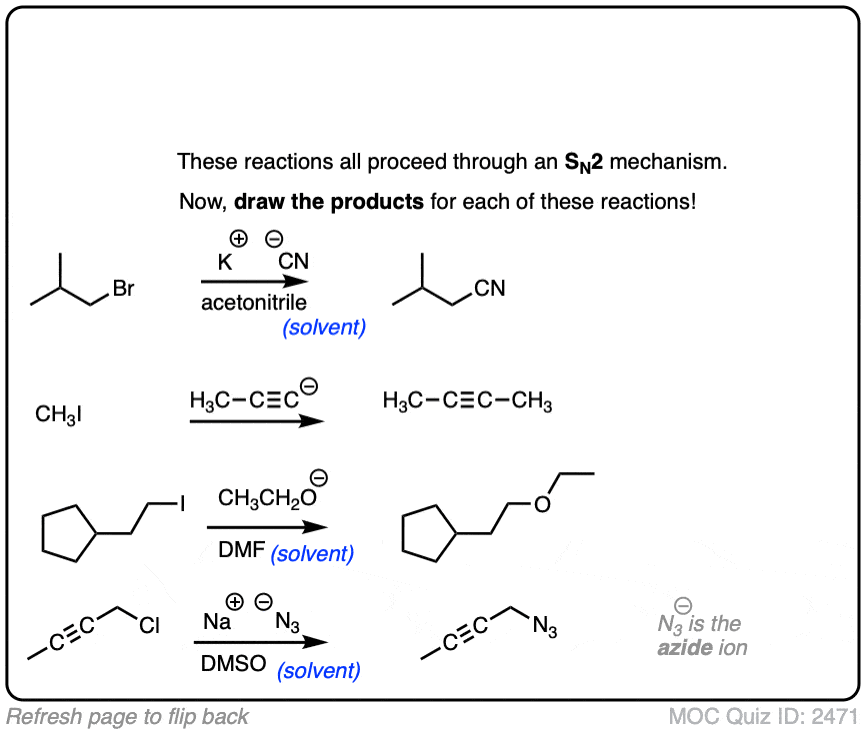
These examples were meant to be straightforward. If you found that those examples of primary alkyl halides were too easy, then have a look at some of these trickier examples below. (Not all of these will necessarily be SN2! )
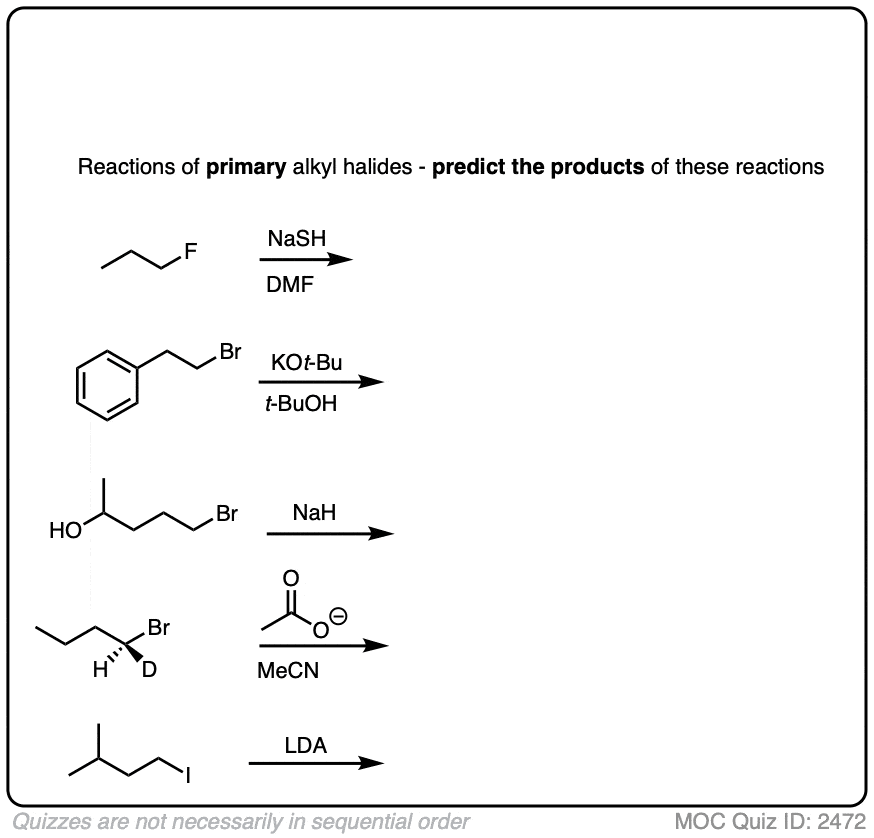 Click to Flip
Click to Flip
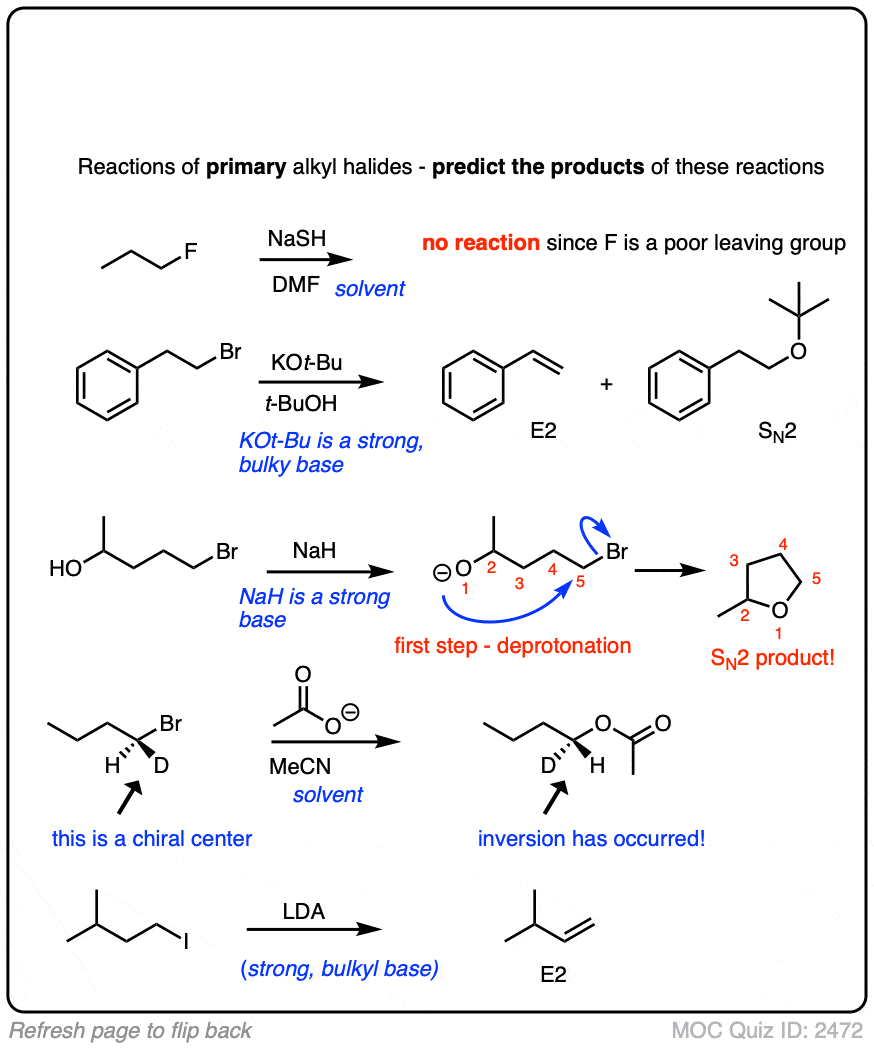
Some additional things to note here:
- Alkyl fluorides do not generally undergo substitution or elimination reactions under normal conditions due to the strong C-F bond.
- Sodium hydride (NaH) is a strong base but a poor nucleophile. It doesn’t attack the carbon to displace a leaving group, but it will deprotonate alcohols to give alkoxides (RO(-) ) which are excellent nucleophiles. [Never forget – the conjugate base is always a better nucleophile! ]
- There is only one situation where another reaction can compete with the SN2 on a primary alkyl halide, and that is when a strong, bulky base such as the t-butoxide ion (e.g. KOt-Bu) or lithium diisopropyl amide (LDA) is used. In these cases, the SN2 is slower than normal due to the steric bulk of the nucleophile, and elimination (E2) may start to compete with SN2. [Note 2]
4. So The Alkyl Halide Is Tertiary – What Then?
Secondary alkyl halides are a bit thorny, so let’s skip them for a moment and move straight to tertiary.
If the substrate is tertiary, you can rule out SN2. Why?
SN2 reactions generally don’t happen on tertiary alkyl halides because the SN2 proceeds through a backside attack (to the C-LG sigma* orbital) , and the backside of tertiary alkyl halides is too sterically hindered for SN2 reactions to occur at any meaningful rate. (See post – Steric Hindrance is Like a Fat Goalie)
Since SN2 is out of the picture, we’re left trying to choose between SN1, E1, and E2.

So what then?
I will cover this in the following article, but I don’t think I’m spoiling anything by saying that the next step is to look for the presence of a good base. [See next article – Deciding SN1/SN2/E1/E2 – The Nucleophile /Base]
By “good base”, I generally mean charged species at least as basic as alkoxides (RO– ) or greater. [although I would also include tertiary amines Note 3 ]
Seeing “heat” or the delta symbol ” Δ” is also a good clue that elimination is going on. [See article – Elimination Reactions Are Favored By Heat]
In the absence of a strong base, expect SN1/E1 with tertiary alkyl halides.
That just opens up another question, of course. How do you tell the difference between SN1 or E1?
This will also be covered in another subsequent article (See article – Deciding SN1/SN2/E1.E2 – The Role of Temperature), but the short answer is, “heat“. If heat is applied, then expect the reaction to be E1.
In the quiz below, which is collected from the examples above, I’ve actually done the work of identifying the most likely reaction pathway. Your job is to just draw the products.
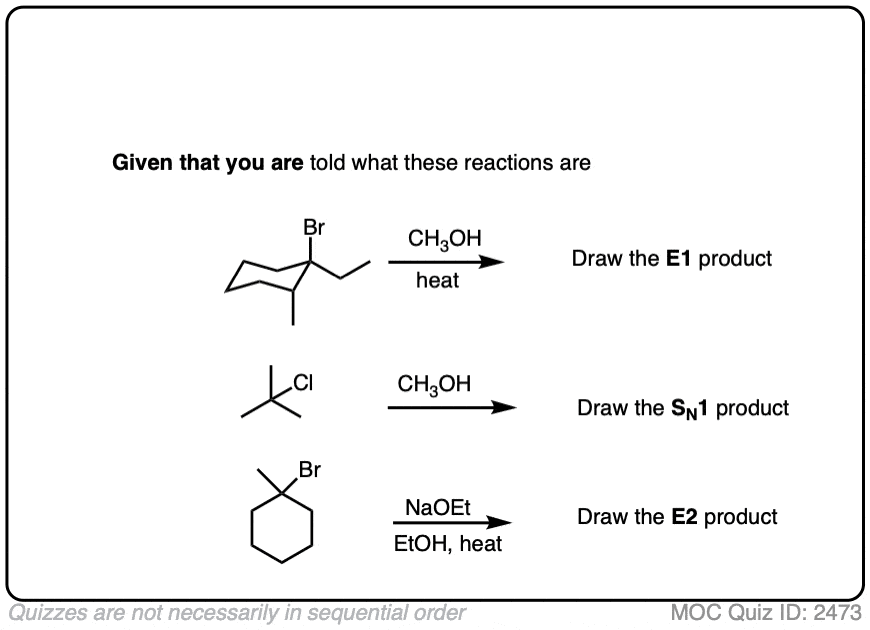 Click to Flip
Click to Flip
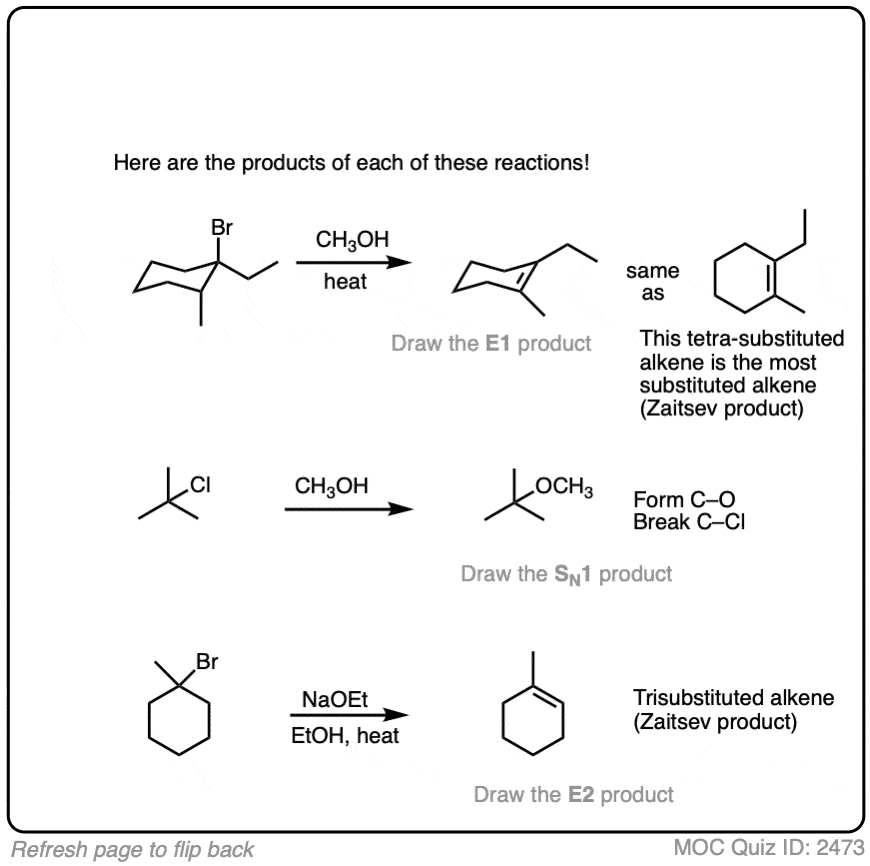
See this Note 4 for the slightly more difficult example.
5. It’s Secondary – Now What?
Finally we get to the “fun” part: secondary alkyl halides. (Note – your definition of “fun” may vary)
The short news is that for secondary alkyl halides, we cant rule anything out. Depending on conditions, each of the four reaction patterns could potentially be observed.
I’m not going to be able to summarize the whole range of possibilities in one paragraph, but the next key question will be to examine the identity of the base / nucleophile.
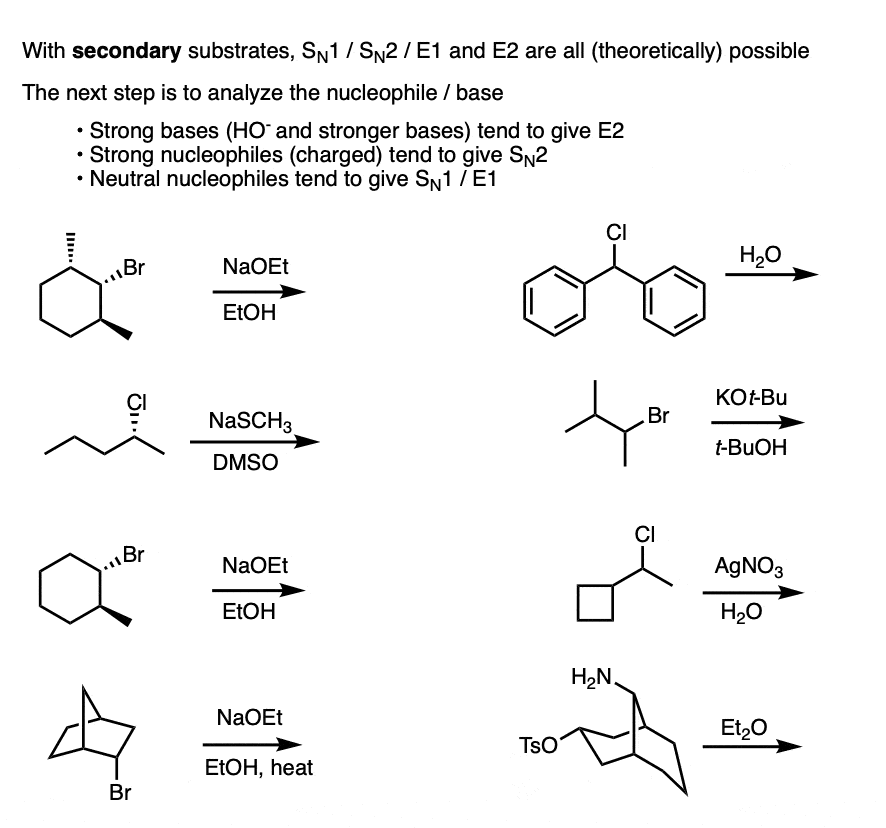
- Generally speaking, if the nucleophile/base is “strong” (and for our purposes, this means, “has a negative charge”) then expect SN2 or E2
- If the nucleophile/base is “weak” (neutral, for our purposes) then expect SN1 / E1.
Distinguishing SN2 vs E2 on a secondary alkyl halide is worth a whole other article on its own.
For now, let’s just note that the E2 requires a strong base, whereas the SN2 requires a strong nucleophile.
By “strong” I would suggest hydroxide ion (HO – , the conjugate base of water, pKa = 14) as a good cutoff point.
- Thiolates, the conjugate bases of thiols (pKa 10) tend to perform substitution reactions on secondary alkyl halides, as do less basic species such as N3(-), CN(-), halides, and carboxylates. (For a good list of nucleophiles, see post – Why The SN2 Is Powerful)
- Ssecondary alkyl halides treated with alkoxides are a particularly tricky case, as this is the borderline region between SN2 and E2. For a good time, ask your instructor on what they think will happen. (My personal observation is that polar aprotic solvents such as DMSO, DMF, and acetonitrile indicate SN2 whereas polar protic solvents indicate E2, but there are exceptions).
- Nucleophiles that are more basic than alkoxides tend to give E2 with secondary alkyl halides. Acetylides, the conjugate bases of terminal alkynes are a classic example here. [Note 5]
Here are some of the simpler examples from above. The more complex ones I’ll cover in the notes below.
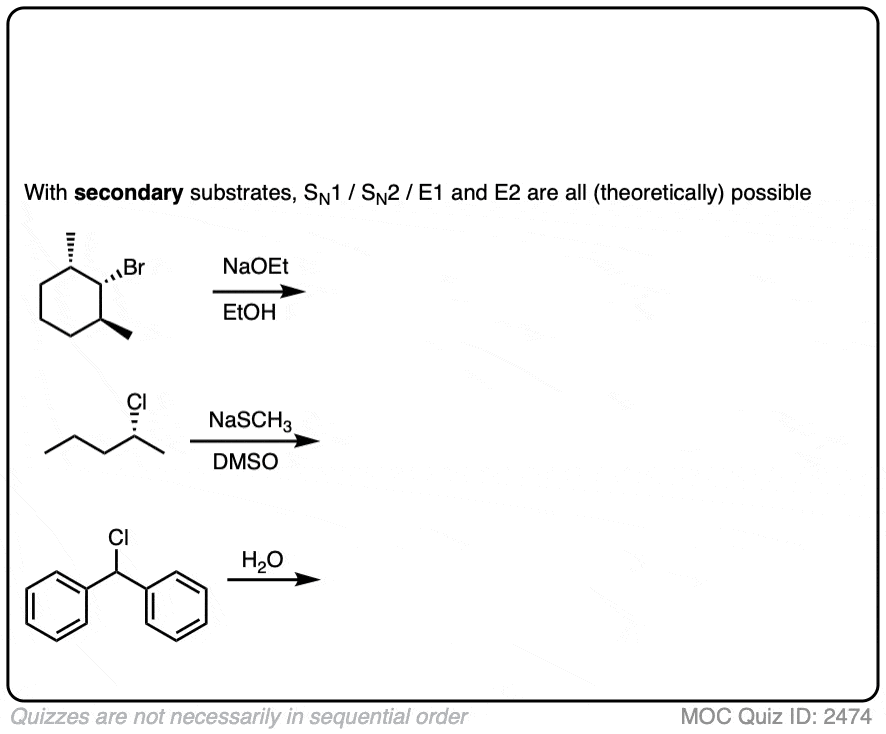 Click to Flip
Click to Flip
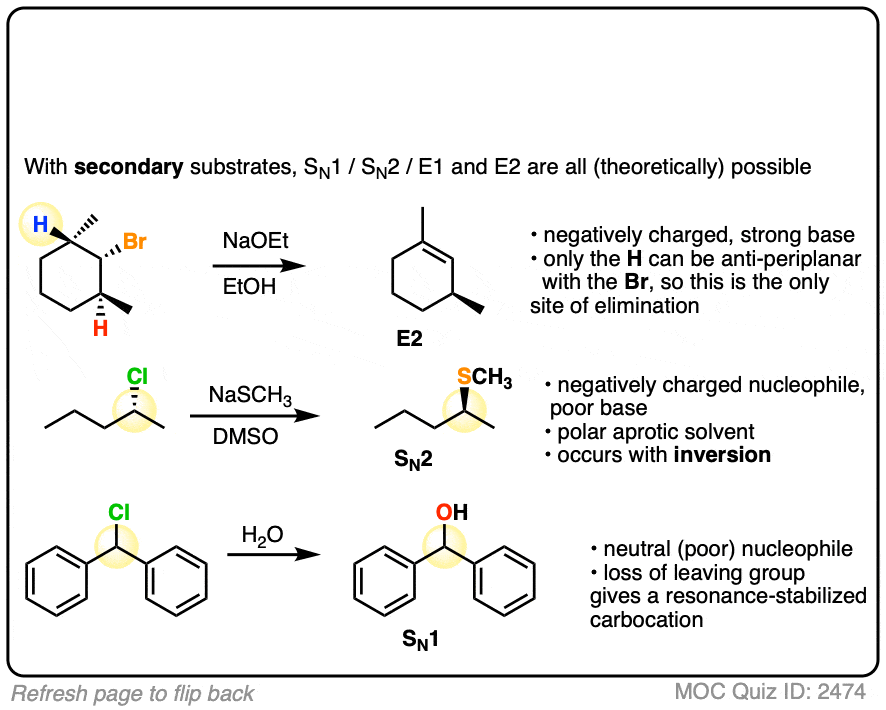
I’ll handle some of the more complicated cases of secondary alkyl halides in the notes below.
6. A Look Ahead
Although this is intended to be just one article in a sequence that walk through the process of deciding SN1/SN2/E1/E2, I appreciate that not everyone will go through this sequentially.
This is an outline of the thought process:
- The role of the substrate (this article)
- The role of the nucleophile/base (next! )
- The role of the solvent (SN2 vs E2 with secondary alkyl halides)
- The role of temperature (SN1 vs E1)
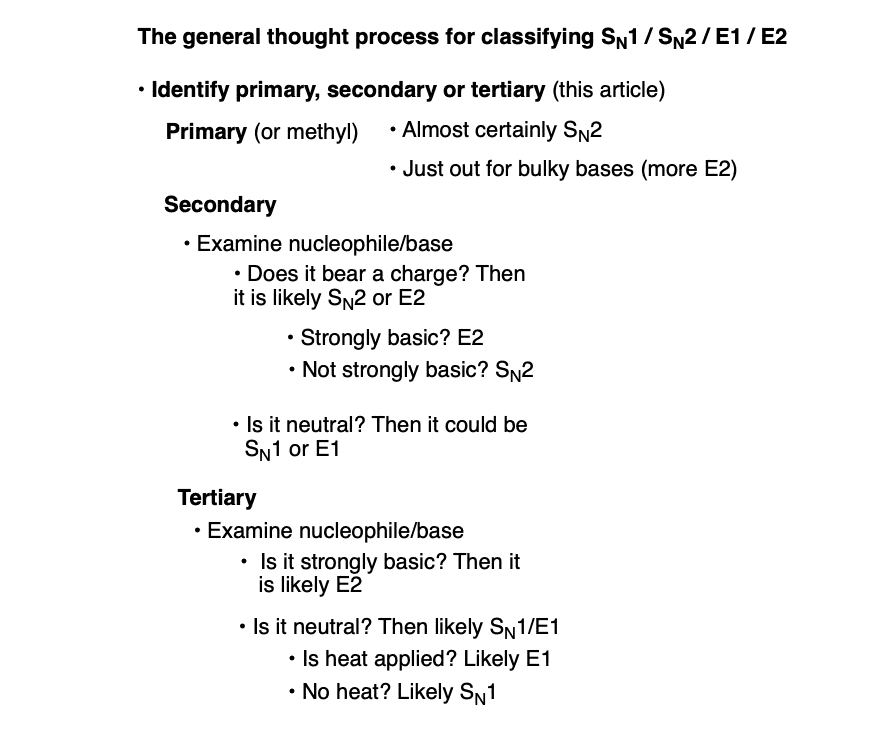
7. Some Examples With Alcohols
We’ve been talking about reactions of alkyl halides, but these reactions can happen with alcohols as well.
In their neutral form alcohols are poor nucleophiles and are also poor substrates for SN1/SN2/E1/E2 reactions since the hydroxide group (HO–) is a poor leaving group.
However, adding an acid or a base can change the alcohol’s personality dramatically!
- Treating an alcohol with a base makes the alcohol into an alkoxide, which is a far better nucleophile than a neutral alcohol.
- Treating an alcohol with an acid protonates the hydroxyl group R–OH into R–OH2(+) which is a far better leaving group than HO(-). This means that protonated alcohols can be electrophiles in SN1/SN2/E1 reactions (but generally not E2, since strong acids aren’t compatible with strong bases!)
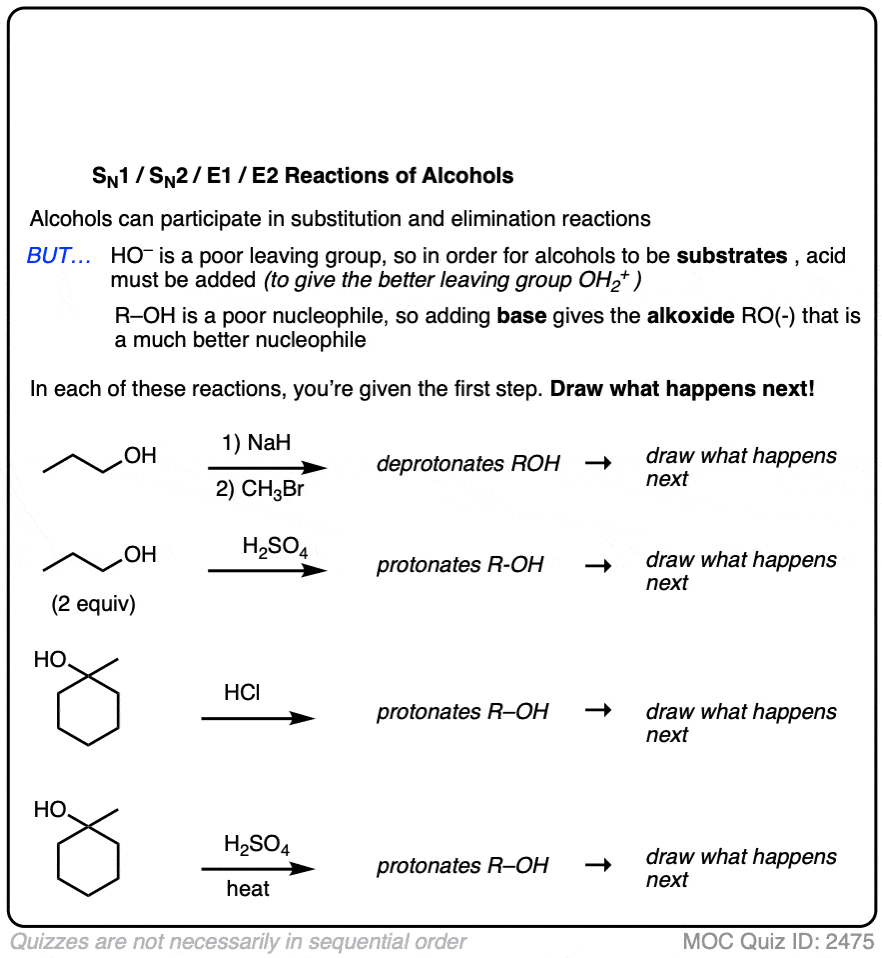 Click to Flip
Click to Flip
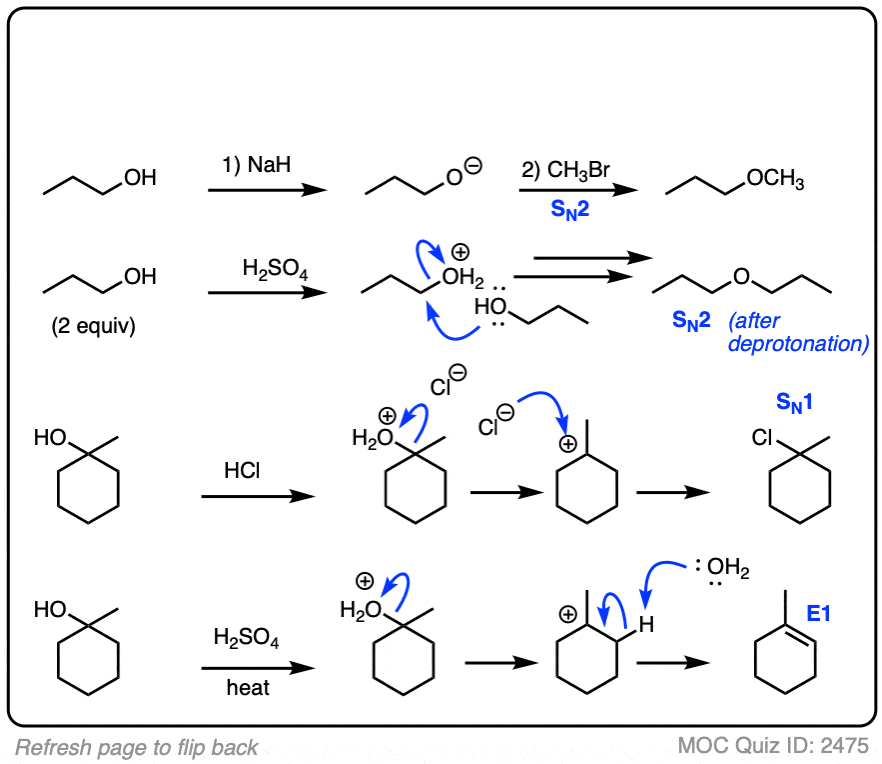
More on the substitution and elimination reactions of alcohols in the alcohol chapter. (Start here, for example)
8. Summary
- Identifying the type of substrate (primary, secondary, tertiary or methyl halide) is the first step towards identifying a reaction as SN1/SN2/E1/E2.
- I personally find it more helpful to look at it from the perspective of ruling things out rather than the inverse.
- If the alkyl halide is primary, you can rule out SN1 and E1, and rule out E2 unless the nucleophile is a very bulky base.
- If the alkyl halide is tertiary, you can rule out SN2.
With secondary alkyl halides, you can’t rule out any pathway in some cases without looking at the nucleophile/base.
That’s next!
Notes
Related Articles
- Deciding SN1/SN2/E1/E2 (2) – The Nucleophile/Base
- Identifying Where Substitution and Elimination Reactions Happen
- SN1 vs E1 and SN2 vs E2 : The Temperature
- The SN1 Mechanism
- The SN2 Mechanism
- The E1 Reaction
- The E2 Mechanism
- 3 Factors That Stabilize Carbocations
- What makes a good leaving group?
- Primary, Secondary, Tertiary, Quaternary In Organic Chemistry
- SN1 SN2 E1 E2 Practice Problems (MOC Membership)
Note 1. It is also possible for the SN1 pathway to operate with primary allylic halides that are capable of forming extremely stable carbocations, particularly in very polar solvents such as mixtures of water and ethanol or formic acid.
One classic example is gamma, gamma dimethylallyl chloride, where the SN1 pathway is dominant.
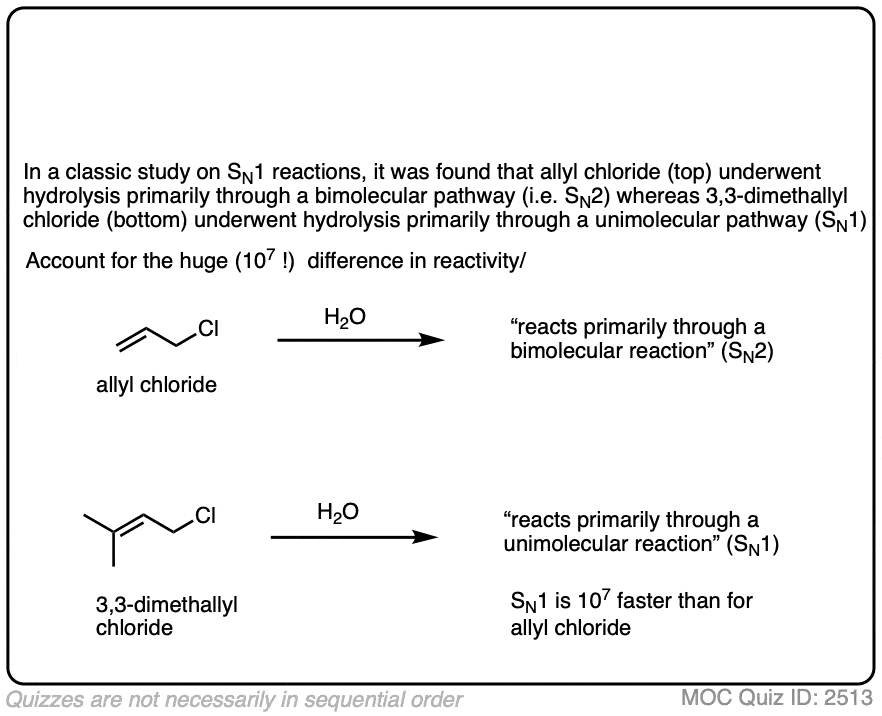 Click to Flip
Click to Flip
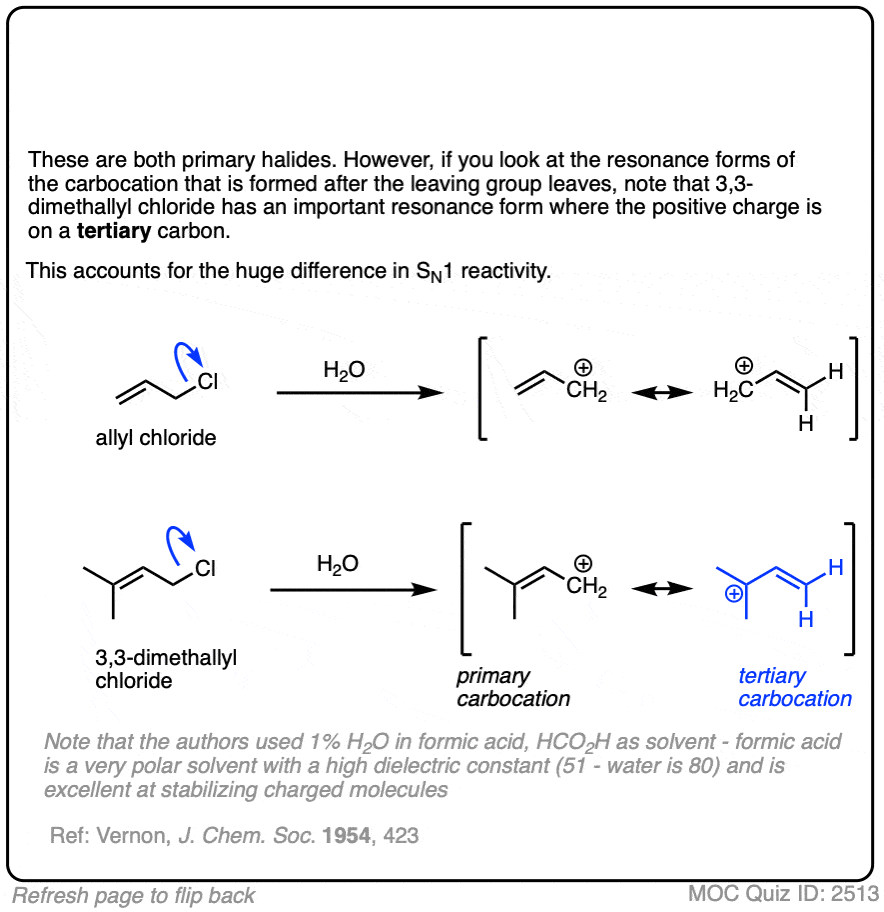
Note 2. Note that I’m not saying here that E2 will be the exclusive (100%) product, just that the percentage of E2 product will start to increase relative to SN2. Mixtures of products are fairly common in organic chemistry.
Note 3. Tertiary amines (R3N) are one example of an exception to this rule of thumb, as they are neutral species yet competent bases.
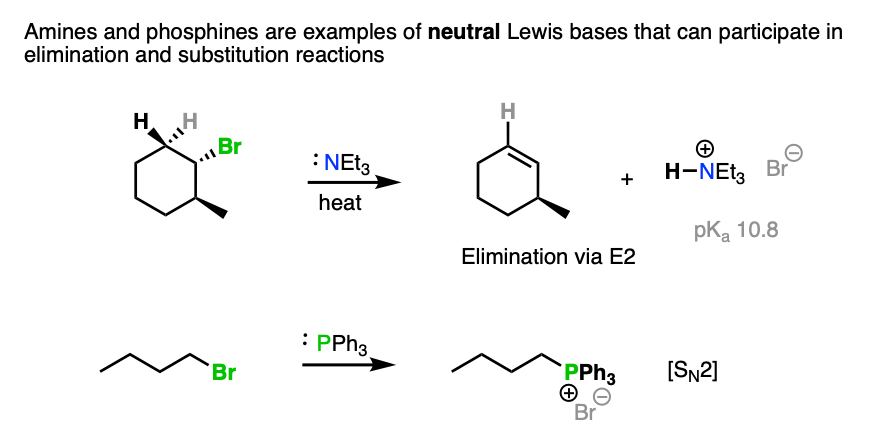
Phosphines (e.g. triphenylphosphine, PPh3) are poor bases but are excellent nucleophiles in SN2 reactions.
Note 4. If a carbocation is formed in the presence of a species that is a good nucleophile but a poor base, such as cyanide or azide ion, then these good nucleophiles can “intercept” the carbocation and react with it in place of the solvent.
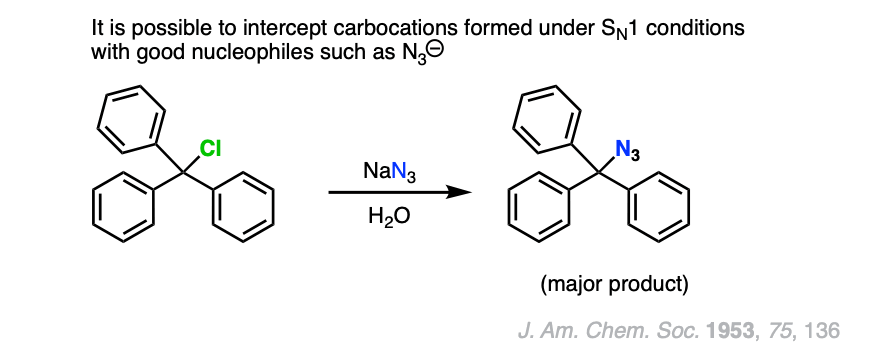
Note 5. When secondary alkyl halides are treated with acetylides, the major product tends to be elimination rather than substitution products.
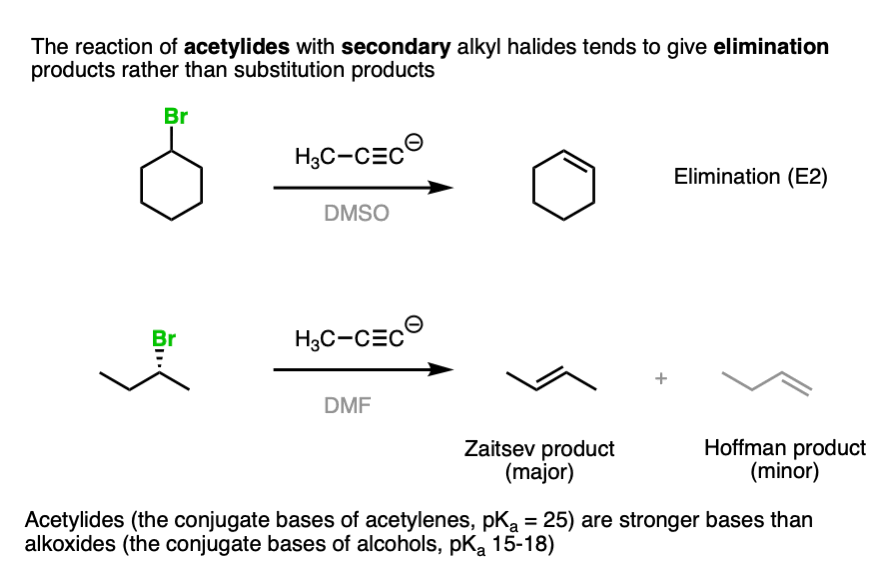
For examples, see this reference.
Note 6. This is a handy table of relative rates for various alkyl halides in substitution reactions with halide ions.
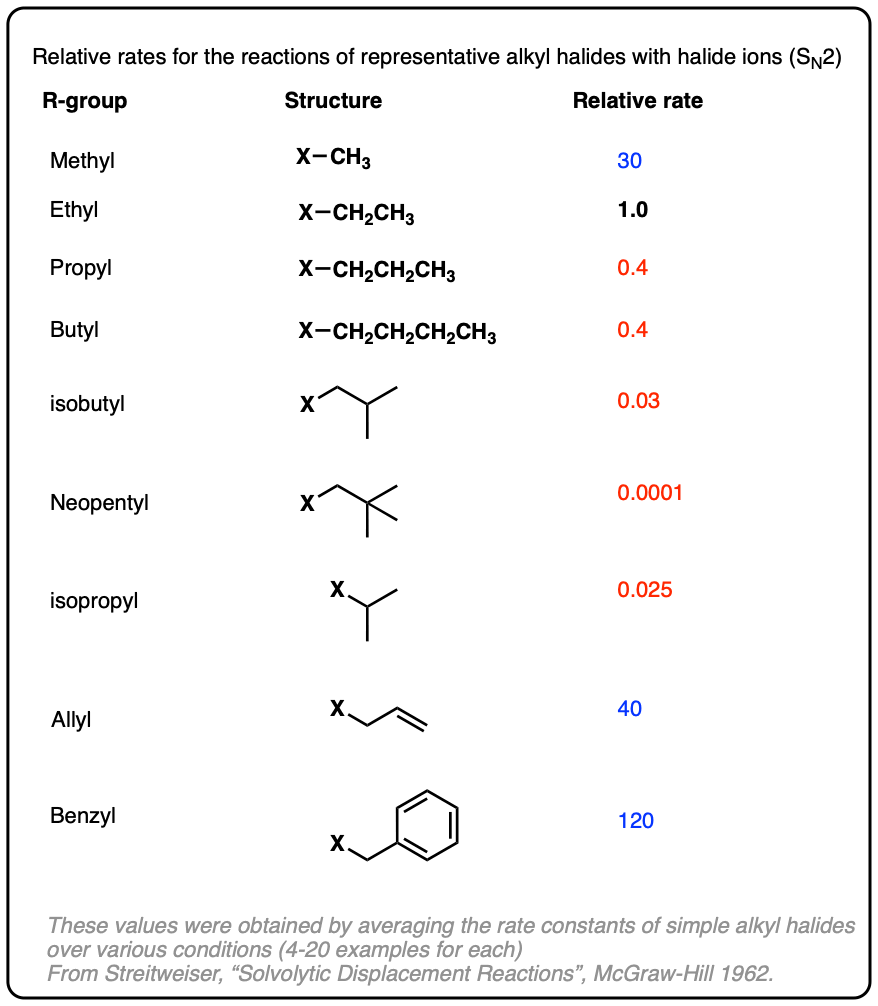
Quiz Yourself!
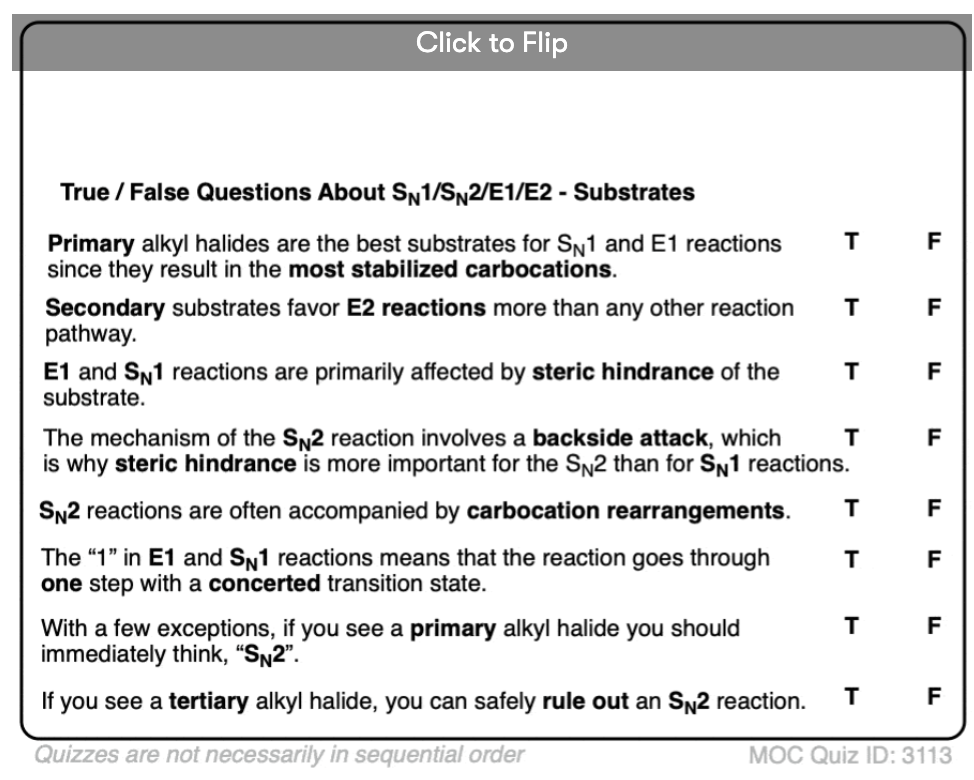
Become a MOC member to see the clickable quiz with answers on the back.
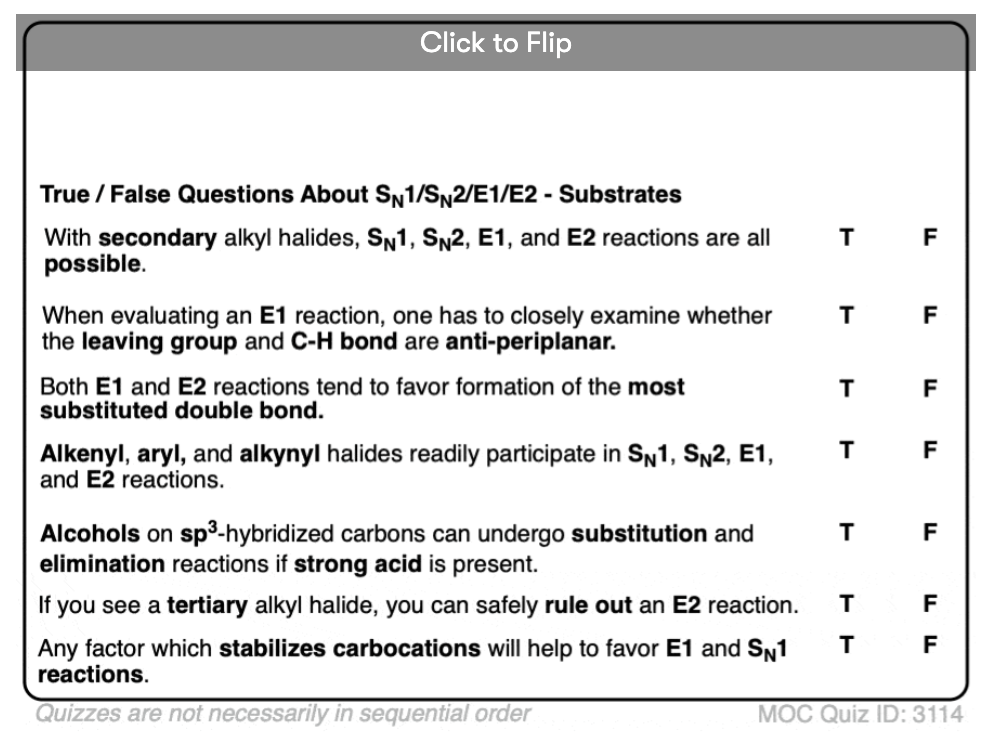
Become a MOC member to see the clickable quiz with answers on the back.
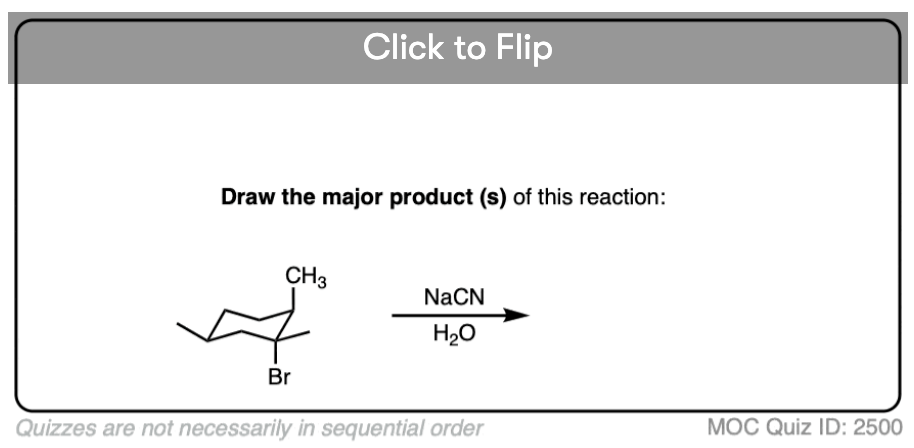
Become a MOC member to see the clickable quiz with answers on the back.
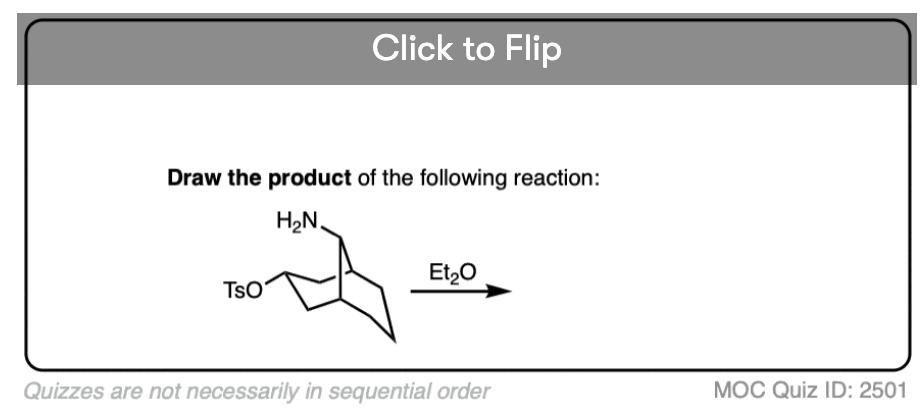
Become a MOC member to see the clickable quiz with answers on the back.
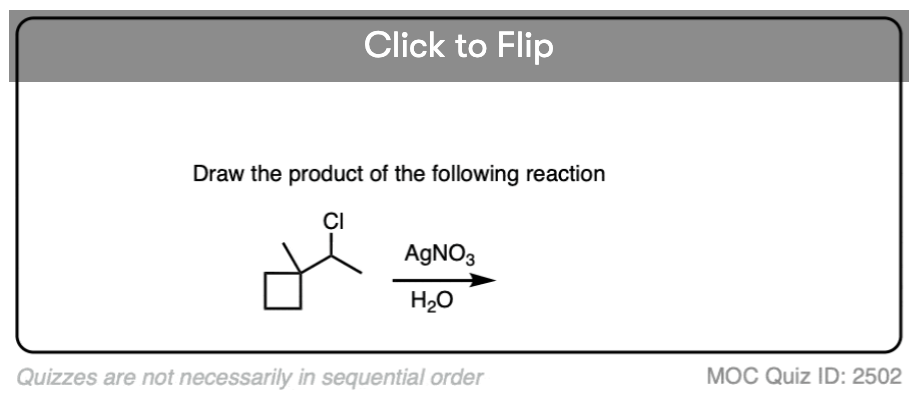
Become a MOC member to see the clickable quiz with answers on the back.
(Advanced) References and Further Reading
One key reference for understanding the interplay between SN1/SN2/E1 and E2 reactions is an older, but very valuable review by Prof. Andrew Streitweiser (Berkeley) in “Solvolytic Displacement Reactions” (McGraw-Hill, 1962, New York) which summarizes hundreds of publications on the subject prior to 1960. Most of the book is a republication of an earlier review by Streitweiser bearing the same title. (Chemical Reviews, 1956, 56, 571)
- Kinetics and mechanisms of nucleophilic displacements in allylic systems. Part VIII. The reactivities of allylic chlorides towards bimolecular substitution without rearrangement
C. A. Vernon
J. Chem. Soc., 1954, 4462-4470
DOI: 10.1039/JR9540004462 -
The kinetics and mechanisms of nucleophilic displacements in allylic systems. Part V. Reactivities of allylic halides by the SN1 mechanism of hydrolysis
C. A. Vernon
J. Chem. Soc., 1954, 423-428
DOI: 10.1039/JR9540000423
Study on the SN1 pathway (solvolysis) for several primary allylic chlorides. The SN1 pathway for the hydrolysis gamma,gamma-dimethallyl chloride in formic acid is particularly significant, relative to allyl chloride. - Preparation of Alkynes and Dialkynes by Reaction of Monohalo- and Dihaloalkanes with Lithium Acetylenide-Ethylenediamine Complex
W. Novis SMITH* , O. F. BEUMEL, Jr.
Synthesis, 1974, 441-443.
DOI: 10.1055/s-1974-23341
Study on the SN2 reaction of lithium acetylides with various primary alkyl halides (primary alkyl iodides and bromides are fast, primary alkyl chlorides are slow, secondary alkyl halides give elimination) - SN2 versus SN2′ Competition
Thomas Hansen, Pascal Vermeeren, Lea de Jong, F. Matthias Bickelhaupt, and Trevor A. Hamlin
The Journal of Organic Chemistry 2022 87 (14), 8892-8901
DOI: 10.1021/acs.joc.2c00527
Very recent paper on SN2 (and SN2′) reactions of allyl halides with leading references.
00 General Chemistry Review
01 Bonding, Structure, and Resonance
- How Do We Know Methane (CH4) Is Tetrahedral?
- Hybrid Orbitals and Hybridization
- How To Determine Hybridization: A Shortcut
- Orbital Hybridization And Bond Strengths
- Sigma bonds come in six varieties: Pi bonds come in one
- A Key Skill: How to Calculate Formal Charge
- The Four Intermolecular Forces and How They Affect Boiling Points
- 3 Trends That Affect Boiling Points
- How To Use Electronegativity To Determine Electron Density (and why NOT to trust formal charge)
- Introduction to Resonance
- How To Use Curved Arrows To Interchange Resonance Forms
- Evaluating Resonance Forms (1) - The Rule of Least Charges
- How To Find The Best Resonance Structure By Applying Electronegativity
- Evaluating Resonance Structures With Negative Charges
- Evaluating Resonance Structures With Positive Charge
- Exploring Resonance: Pi-Donation
- Exploring Resonance: Pi-acceptors
- In Summary: Evaluating Resonance Structures
- Drawing Resonance Structures: 3 Common Mistakes To Avoid
- How to apply electronegativity and resonance to understand reactivity
- Bond Hybridization Practice
- Structure and Bonding Practice Quizzes
- Resonance Structures Practice
02 Acid Base Reactions
- Introduction to Acid-Base Reactions
- Acid Base Reactions In Organic Chemistry
- The Stronger The Acid, The Weaker The Conjugate Base
- Walkthrough of Acid-Base Reactions (3) - Acidity Trends
- Five Key Factors That Influence Acidity
- Acid-Base Reactions: Introducing Ka and pKa
- How to Use a pKa Table
- The pKa Table Is Your Friend
- A Handy Rule of Thumb for Acid-Base Reactions
- Acid Base Reactions Are Fast
- pKa Values Span 60 Orders Of Magnitude
- How Protonation and Deprotonation Affect Reactivity
- Acid Base Practice Problems
03 Alkanes and Nomenclature
- Meet the (Most Important) Functional Groups
- Condensed Formulas: Deciphering What the Brackets Mean
- Hidden Hydrogens, Hidden Lone Pairs, Hidden Counterions
- Don't Be Futyl, Learn The Butyls
- Primary, Secondary, Tertiary, Quaternary In Organic Chemistry
- Branching, and Its Affect On Melting and Boiling Points
- The Many, Many Ways of Drawing Butane
- Wedge And Dash Convention For Tetrahedral Carbon
- Common Mistakes in Organic Chemistry: Pentavalent Carbon
- Table of Functional Group Priorities for Nomenclature
- Summary Sheet - Alkane Nomenclature
- Organic Chemistry IUPAC Nomenclature Demystified With A Simple Puzzle Piece Approach
- Boiling Point Quizzes
- Organic Chemistry Nomenclature Quizzes
04 Conformations and Cycloalkanes
- Staggered vs Eclipsed Conformations of Ethane
- Conformational Isomers of Propane
- Newman Projection of Butane (and Gauche Conformation)
- Introduction to Cycloalkanes
- Geometric Isomers In Small Rings: Cis And Trans Cycloalkanes
- Calculation of Ring Strain In Cycloalkanes
- Cycloalkanes - Ring Strain In Cyclopropane And Cyclobutane
- Cyclohexane Conformations
- Cyclohexane Chair Conformation: An Aerial Tour
- How To Draw The Cyclohexane Chair Conformation
- The Cyclohexane Chair Flip
- The Cyclohexane Chair Flip - Energy Diagram
- Substituted Cyclohexanes - Axial vs Equatorial
- Ranking The Bulkiness Of Substituents On Cyclohexanes: "A-Values"
- Cyclohexane Chair Conformation Stability: Which One Is Lower Energy?
- Fused Rings - Cis-Decalin and Trans-Decalin
- Naming Bicyclic Compounds - Fused, Bridged, and Spiro
- Bredt's Rule (And Summary of Cycloalkanes)
- Newman Projection Practice
- Cycloalkanes Practice Problems
05 A Primer On Organic Reactions
- The Most Important Question To Ask When Learning a New Reaction
- Curved Arrows (for reactions)
- Nucleophiles and Electrophiles
- The Three Classes of Nucleophiles
- Nucleophilicity vs. Basicity
- What Makes A Good Nucleophile?
- What Makes A Good Leaving Group?
- 3 Factors That Stabilize Carbocations
- Equilibrium and Energy Relationships
- 7 Factors that stabilize negative charge in organic chemistry
- 7 Factors That Stabilize Positive Charge in Organic Chemistry
- What's a Transition State?
- Hammond's Postulate
- Learning Organic Chemistry Reactions: A Checklist (PDF)
- Introduction to Oxidative Cleavage Reactions
06 Free Radical Reactions
- Bond Dissociation Energies = Homolytic Cleavage
- Free Radical Reactions
- 3 Factors That Stabilize Free Radicals
- What Factors Destabilize Free Radicals?
- Bond Strengths And Radical Stability
- Free Radical Initiation: Why Is "Light" Or "Heat" Required?
- Initiation, Propagation, Termination
- Monochlorination Products Of Propane, Pentane, And Other Alkanes
- Selectivity In Free Radical Reactions
- Selectivity in Free Radical Reactions: Bromination vs. Chlorination
- Halogenation At Tiffany's
- Allylic Bromination
- Bonus Topic: Allylic Rearrangements
- In Summary: Free Radicals
- Synthesis (2) - Reactions of Alkanes
- Free Radicals Practice Quizzes
07 Stereochemistry and Chirality
- Types of Isomers: Constitutional Isomers, Stereoisomers, Enantiomers, and Diastereomers
- How To Draw The Enantiomer Of A Chiral Molecule
- How To Draw A Bond Rotation
- Introduction to Assigning (R) and (S): The Cahn-Ingold-Prelog Rules
- Assigning Cahn-Ingold-Prelog (CIP) Priorities (2) - The Method of Dots
- Enantiomers vs Diastereomers vs The Same? Two Methods For Solving Problems
- Assigning R/S To Newman Projections (And Converting Newman To Line Diagrams)
- How To Determine R and S Configurations On A Fischer Projection
- The Meso Trap
- Optical Rotation, Optical Activity, and Specific Rotation
- Optical Purity and Enantiomeric Excess
- What's a Racemic Mixture?
- Chiral Allenes And Chiral Axes
- Stereochemistry Practice Problems and Quizzes
08 Substitution Reactions
- Nucleophilic Substitution Reactions - Introduction
- Two Types of Nucleophilic Substitution Reactions
- The SN2 Mechanism
- Why the SN2 Reaction Is Powerful
- The SN1 Mechanism
- The Conjugate Acid Is A Better Leaving Group
- Comparing the SN1 and SN2 Reactions
- Polar Protic? Polar Aprotic? Nonpolar? All About Solvents
- Steric Hindrance is Like a Fat Goalie
- Common Blind Spot: Intramolecular Reactions
- Substitution Practice - SN1
- Substitution Practice - SN2
09 Elimination Reactions
- Elimination Reactions (1): Introduction And The Key Pattern
- Elimination Reactions (2): The Zaitsev Rule
- Elimination Reactions Are Favored By Heat
- Two Elimination Reaction Patterns
- The E1 Reaction
- The E2 Mechanism
- E1 vs E2: Comparing the E1 and E2 Reactions
- Antiperiplanar Relationships: The E2 Reaction and Cyclohexane Rings
- Bulky Bases in Elimination Reactions
- Comparing the E1 vs SN1 Reactions
- Elimination (E1) Reactions With Rearrangements
- E1cB - Elimination (Unimolecular) Conjugate Base
- Elimination (E1) Practice Problems And Solutions
- Elimination (E2) Practice Problems and Solutions
10 Rearrangements
11 SN1/SN2/E1/E2 Decision
- Identifying Where Substitution and Elimination Reactions Happen
- Deciding SN1/SN2/E1/E2 (1) - The Substrate
- Deciding SN1/SN2/E1/E2 (2) - The Nucleophile/Base
- SN1 vs E1 and SN2 vs E2 : The Temperature
- Deciding SN1/SN2/E1/E2 - The Solvent
- Wrapup: The Key Factors For Determining SN1/SN2/E1/E2
- Alkyl Halide Reaction Map And Summary
- SN1 SN2 E1 E2 Practice Problems
12 Alkene Reactions
- E and Z Notation For Alkenes (+ Cis/Trans)
- Alkene Stability
- Alkene Addition Reactions: "Regioselectivity" and "Stereoselectivity" (Syn/Anti)
- Stereoselective and Stereospecific Reactions
- Hydrohalogenation of Alkenes and Markovnikov's Rule
- Hydration of Alkenes With Aqueous Acid
- Rearrangements in Alkene Addition Reactions
- Halogenation of Alkenes and Halohydrin Formation
- Oxymercuration Demercuration of Alkenes
- Hydroboration Oxidation of Alkenes
- m-CPBA (meta-chloroperoxybenzoic acid)
- OsO4 (Osmium Tetroxide) for Dihydroxylation of Alkenes
- Palladium on Carbon (Pd/C) for Catalytic Hydrogenation of Alkenes
- Cyclopropanation of Alkenes
- A Fourth Alkene Addition Pattern - Free Radical Addition
- Alkene Reactions: Ozonolysis
- Summary: Three Key Families Of Alkene Reaction Mechanisms
- Synthesis (4) - Alkene Reaction Map, Including Alkyl Halide Reactions
- Alkene Reactions Practice Problems
13 Alkyne Reactions
- Acetylides from Alkynes, And Substitution Reactions of Acetylides
- Partial Reduction of Alkynes With Lindlar's Catalyst
- Partial Reduction of Alkynes With Na/NH3 To Obtain Trans Alkenes
- Alkyne Hydroboration With "R2BH"
- Hydration and Oxymercuration of Alkynes
- Hydrohalogenation of Alkynes
- Alkyne Halogenation: Bromination, Chlorination, and Iodination of Alkynes
- Alkyne Reactions - The "Concerted" Pathway
- Alkenes To Alkynes Via Halogenation And Elimination Reactions
- Alkynes Are A Blank Canvas
- Synthesis (5) - Reactions of Alkynes
- Alkyne Reactions Practice Problems With Answers
14 Alcohols, Epoxides and Ethers
- Alcohols - Nomenclature and Properties
- Alcohols Can Act As Acids Or Bases (And Why It Matters)
- Alcohols - Acidity and Basicity
- The Williamson Ether Synthesis
- Ethers From Alkenes, Tertiary Alkyl Halides and Alkoxymercuration
- Alcohols To Ethers via Acid Catalysis
- Cleavage Of Ethers With Acid
- Epoxides - The Outlier Of The Ether Family
- Opening of Epoxides With Acid
- Epoxide Ring Opening With Base
- Making Alkyl Halides From Alcohols
- Tosylates And Mesylates
- PBr3 and SOCl2
- Elimination Reactions of Alcohols
- Elimination of Alcohols To Alkenes With POCl3
- Alcohol Oxidation: "Strong" and "Weak" Oxidants
- Demystifying The Mechanisms of Alcohol Oxidations
- Protecting Groups For Alcohols
- Thiols And Thioethers
- Calculating the oxidation state of a carbon
- Oxidation and Reduction in Organic Chemistry
- Oxidation Ladders
- SOCl2 Mechanism For Alcohols To Alkyl Halides: SN2 versus SNi
- Alcohol Reactions Roadmap (PDF)
- Alcohol Reaction Practice Problems
- Epoxide Reaction Quizzes
- Oxidation and Reduction Practice Quizzes
15 Organometallics
- What's An Organometallic?
- Formation of Grignard and Organolithium Reagents
- Organometallics Are Strong Bases
- Reactions of Grignard Reagents
- Protecting Groups In Grignard Reactions
- Synthesis Problems Involving Grignard Reagents
- Grignard Reactions And Synthesis (2)
- Organocuprates (Gilman Reagents): How They're Made
- Gilman Reagents (Organocuprates): What They're Used For
- The Heck, Suzuki, and Olefin Metathesis Reactions (And Why They Don't Belong In Most Introductory Organic Chemistry Courses)
- Reaction Map: Reactions of Organometallics
- Grignard Practice Problems
16 Spectroscopy
- Degrees of Unsaturation (or IHD, Index of Hydrogen Deficiency)
- Conjugation And Color (+ How Bleach Works)
- Introduction To UV-Vis Spectroscopy
- UV-Vis Spectroscopy: Absorbance of Carbonyls
- UV-Vis Spectroscopy: Practice Questions
- Bond Vibrations, Infrared Spectroscopy, and the "Ball and Spring" Model
- Infrared Spectroscopy: A Quick Primer On Interpreting Spectra
- IR Spectroscopy: 4 Practice Problems
- 1H NMR: How Many Signals?
- Homotopic, Enantiotopic, Diastereotopic
- Diastereotopic Protons in 1H NMR Spectroscopy: Examples
- 13-C NMR - How Many Signals
- Liquid Gold: Pheromones In Doe Urine
- Natural Product Isolation (1) - Extraction
- Natural Product Isolation (2) - Purification Techniques, An Overview
- Structure Determination Case Study: Deer Tarsal Gland Pheromone
17 Dienes and MO Theory
- What To Expect In Organic Chemistry 2
- Are these molecules conjugated?
- Conjugation And Resonance In Organic Chemistry
- Bonding And Antibonding Pi Orbitals
- Molecular Orbitals of The Allyl Cation, Allyl Radical, and Allyl Anion
- Pi Molecular Orbitals of Butadiene
- Reactions of Dienes: 1,2 and 1,4 Addition
- Thermodynamic and Kinetic Products
- More On 1,2 and 1,4 Additions To Dienes
- s-cis and s-trans
- The Diels-Alder Reaction
- Cyclic Dienes and Dienophiles in the Diels-Alder Reaction
- Stereochemistry of the Diels-Alder Reaction
- Exo vs Endo Products In The Diels Alder: How To Tell Them Apart
- HOMO and LUMO In the Diels Alder Reaction
- Why Are Endo vs Exo Products Favored in the Diels-Alder Reaction?
- Diels-Alder Reaction: Kinetic and Thermodynamic Control
- The Retro Diels-Alder Reaction
- The Intramolecular Diels Alder Reaction
- Regiochemistry In The Diels-Alder Reaction
- The Cope and Claisen Rearrangements
- Electrocyclic Reactions
- Electrocyclic Ring Opening And Closure (2) - Six (or Eight) Pi Electrons
- Diels Alder Practice Problems
- Molecular Orbital Theory Practice
18 Aromaticity
- Introduction To Aromaticity
- Rules For Aromaticity
- Huckel's Rule: What Does 4n+2 Mean?
- Aromatic, Non-Aromatic, or Antiaromatic? Some Practice Problems
- Antiaromatic Compounds and Antiaromaticity
- The Pi Molecular Orbitals of Benzene
- The Pi Molecular Orbitals of Cyclobutadiene
- Frost Circles
- Aromaticity Practice Quizzes
19 Reactions of Aromatic Molecules
- Electrophilic Aromatic Substitution: Introduction
- Activating and Deactivating Groups In Electrophilic Aromatic Substitution
- Electrophilic Aromatic Substitution - The Mechanism
- Ortho-, Para- and Meta- Directors in Electrophilic Aromatic Substitution
- Understanding Ortho, Para, and Meta Directors
- Why are halogens ortho- para- directors?
- Disubstituted Benzenes: The Strongest Electron-Donor "Wins"
- Electrophilic Aromatic Substitutions (1) - Halogenation of Benzene
- Electrophilic Aromatic Substitutions (2) - Nitration and Sulfonation
- EAS Reactions (3) - Friedel-Crafts Acylation and Friedel-Crafts Alkylation
- Intramolecular Friedel-Crafts Reactions
- Nucleophilic Aromatic Substitution (NAS)
- Nucleophilic Aromatic Substitution (2) - The Benzyne Mechanism
- Reactions on the "Benzylic" Carbon: Bromination And Oxidation
- The Wolff-Kishner, Clemmensen, And Other Carbonyl Reductions
- More Reactions on the Aromatic Sidechain: Reduction of Nitro Groups and the Baeyer Villiger
- Aromatic Synthesis (1) - "Order Of Operations"
- Synthesis of Benzene Derivatives (2) - Polarity Reversal
- Aromatic Synthesis (3) - Sulfonyl Blocking Groups
- Birch Reduction
- Synthesis (7): Reaction Map of Benzene and Related Aromatic Compounds
- Aromatic Reactions and Synthesis Practice
- Electrophilic Aromatic Substitution Practice Problems
20 Aldehydes and Ketones
- What's The Alpha Carbon In Carbonyl Compounds?
- Nucleophilic Addition To Carbonyls
- Aldehydes and Ketones: 14 Reactions With The Same Mechanism
- Sodium Borohydride (NaBH4) Reduction of Aldehydes and Ketones
- Grignard Reagents For Addition To Aldehydes and Ketones
- Wittig Reaction
- Hydrates, Hemiacetals, and Acetals
- Imines - Properties, Formation, Reactions, and Mechanisms
- All About Enamines
- Breaking Down Carbonyl Reaction Mechanisms: Reactions of Anionic Nucleophiles (Part 2)
- Aldehydes Ketones Reaction Practice
21 Carboxylic Acid Derivatives
- Nucleophilic Acyl Substitution (With Negatively Charged Nucleophiles)
- Addition-Elimination Mechanisms With Neutral Nucleophiles (Including Acid Catalysis)
- Basic Hydrolysis of Esters - Saponification
- Transesterification
- Proton Transfer
- Fischer Esterification - Carboxylic Acid to Ester Under Acidic Conditions
- Lithium Aluminum Hydride (LiAlH4) For Reduction of Carboxylic Acid Derivatives
- LiAlH[Ot-Bu]3 For The Reduction of Acid Halides To Aldehydes
- Di-isobutyl Aluminum Hydride (DIBAL) For The Partial Reduction of Esters and Nitriles
- Amide Hydrolysis
- Thionyl Chloride (SOCl2)
- Diazomethane (CH2N2)
- Carbonyl Chemistry: Learn Six Mechanisms For the Price Of One
- Making Music With Mechanisms (PADPED)
- Carboxylic Acid Derivatives Practice Questions
22 Enols and Enolates
- Keto-Enol Tautomerism
- Enolates - Formation, Stability, and Simple Reactions
- Kinetic Versus Thermodynamic Enolates
- Aldol Addition and Condensation Reactions
- Reactions of Enols - Acid-Catalyzed Aldol, Halogenation, and Mannich Reactions
- Claisen Condensation and Dieckmann Condensation
- Decarboxylation
- The Malonic Ester and Acetoacetic Ester Synthesis
- The Michael Addition Reaction and Conjugate Addition
- The Robinson Annulation
- Haloform Reaction
- The Hell–Volhard–Zelinsky Reaction
- Enols and Enolates Practice Quizzes
23 Amines
- The Amide Functional Group: Properties, Synthesis, and Nomenclature
- Basicity of Amines And pKaH
- 5 Key Basicity Trends of Amines
- The Mesomeric Effect And Aromatic Amines
- Nucleophilicity of Amines
- Alkylation of Amines (Sucks!)
- Reductive Amination
- The Gabriel Synthesis
- Some Reactions of Azides
- The Hofmann Elimination
- The Hofmann and Curtius Rearrangements
- The Cope Elimination
- Protecting Groups for Amines - Carbamates
- The Strecker Synthesis of Amino Acids
- Introduction to Peptide Synthesis
- Reactions of Diazonium Salts: Sandmeyer and Related Reactions
- Amine Practice Questions
24 Carbohydrates
- D and L Notation For Sugars
- Pyranoses and Furanoses: Ring-Chain Tautomerism In Sugars
- What is Mutarotation?
- Reducing Sugars
- The Big Damn Post Of Carbohydrate-Related Chemistry Definitions
- The Haworth Projection
- Converting a Fischer Projection To A Haworth (And Vice Versa)
- Reactions of Sugars: Glycosylation and Protection
- The Ruff Degradation and Kiliani-Fischer Synthesis
- Isoelectric Points of Amino Acids (and How To Calculate Them)
- Carbohydrates Practice
- Amino Acid Quizzes
25 Fun and Miscellaneous
- A Gallery of Some Interesting Molecules From Nature
- Screw Organic Chemistry, I'm Just Going To Write About Cats
- On Cats, Part 1: Conformations and Configurations
- On Cats, Part 2: Cat Line Diagrams
- On Cats, Part 4: Enantiocats
- On Cats, Part 6: Stereocenters
- Organic Chemistry Is Shit
- The Organic Chemistry Behind "The Pill"
- Maybe they should call them, "Formal Wins" ?
- Why Do Organic Chemists Use Kilocalories?
- The Principle of Least Effort
- Organic Chemistry GIFS - Resonance Forms
- Reproducibility In Organic Chemistry
- What Holds The Nucleus Together?
- How Reactions Are Like Music
- Organic Chemistry and the New MCAT
26 Organic Chemistry Tips and Tricks
- Common Mistakes: Formal Charges Can Mislead
- Partial Charges Give Clues About Electron Flow
- Draw The Ugly Version First
- Organic Chemistry Study Tips: Learn the Trends
- The 8 Types of Arrows In Organic Chemistry, Explained
- Top 10 Skills To Master Before An Organic Chemistry 2 Final
- Common Mistakes with Carbonyls: Carboxylic Acids... Are Acids!
- Planning Organic Synthesis With "Reaction Maps"
- Alkene Addition Pattern #1: The "Carbocation Pathway"
- Alkene Addition Pattern #2: The "Three-Membered Ring" Pathway
- Alkene Addition Pattern #3: The "Concerted" Pathway
- Number Your Carbons!
- The 4 Major Classes of Reactions in Org 1
- How (and why) electrons flow
- Grossman's Rule
- Three Exam Tips
- A 3-Step Method For Thinking Through Synthesis Problems
- Putting It Together
- Putting Diels-Alder Products in Perspective
- The Ups and Downs of Cyclohexanes
- The Most Annoying Exceptions in Org 1 (Part 1)
- The Most Annoying Exceptions in Org 1 (Part 2)
- The Marriage May Be Bad, But the Divorce Still Costs Money
- 9 Nomenclature Conventions To Know
- Nucleophile attacks Electrophile
27 Case Studies of Successful O-Chem Students
- Success Stories: How Corina Got The The "Hard" Professor - And Got An A+ Anyway
- How Helena Aced Organic Chemistry
- From a "Drop" To B+ in Org 2 – How A Hard Working Student Turned It Around
- How Serge Aced Organic Chemistry
- Success Stories: How Zach Aced Organic Chemistry 1
- Success Stories: How Kari Went From C– to B+
- How Esther Bounced Back From a "C" To Get A's In Organic Chemistry 1 And 2
- How Tyrell Got The Highest Grade In Her Organic Chemistry Course
- This Is Why Students Use Flashcards
- Success Stories: How Stu Aced Organic Chemistry
- How John Pulled Up His Organic Chemistry Exam Grades
- Success Stories: How Nathan Aced Organic Chemistry (Without It Taking Over His Life)
- How Chris Aced Org 1 and Org 2
- Interview: How Jay Got an A+ In Organic Chemistry
- How to Do Well in Organic Chemistry: One Student's Advice
- "America's Top TA" Shares His Secrets For Teaching O-Chem
- "Organic Chemistry Is Like..." - A Few Metaphors
- How To Do Well In Organic Chemistry: Advice From A Tutor
- Guest post: "I went from being afraid of tests to actually looking forward to them".
hello sir,
in the question associated with MOC quiz-id 2502, will not the carbocation rearrange once more via 1,2-hydride shift to the position marked “1”, because in doing so it will obtain a larger number of alpha-hydrogen (7 vs 3 as compared to position marked “2”), leading to a greater extent of no-bond resonance?
Good question. I’m going to fix this quiz and put a CH3 on C-2 so this is unambiguous.
Hello there I just wanted to know whether sodium ethoxide is a good base or a good nucleophile since there was a question in my exam where a tertiary halide was treated with sodium ethoxide in the presence of heat and we obtained a substitution product rather than elimination I always wondered sodium ethoxide was a good base
Really!?? I’d love to see it.
Sodium ethoxide should be doing an elimination in that case, never a substitution.
ok so i have a question about what if in differentiating either an SN1 or an SN2 reaction lets say the substrate is a 6 carbon single chain on the 2nd carbon with a wedge of H and ladder on that same carbon with a Cl and a attacking nucleophile of Br-. how can you tell that this is an SN2?
For an Sn1 imagine a 5 carbon chain with carbon 2 has wedge of Br and ladder of H with nucleophile of Cl- how can you tell if its a SN1 reaction. like that what I’m having problem with. please let me know asap i have my exam on Thursday!
Here would be the thought process:
1) Secondary carbon. Can’t rule anything out at this stage.
2) Identity of nucleophile/base: Br(-). Good nucleophile (negatively charged), weak base. Rule out E2 because E2 needs a strong base. Rule out SN1/E1 because they operate with weak (generally neutral) bases. That leaves SN2.
3) So draw product of SN2 with inversion of configuration.
hi, i was just wondering if a compound like (R) 2-bromopropan-1-ol was to undergo a substitution reaction with NaCN, and it resulted in the (R) configuration of the product with the bromine being substituted by the cyanide, which reaction mechanism does it do it by? SN1 or SN2?
can the compound undergo frontside attack by any mechanism because it is a secondary compound?
You might want to look into the subject of “double inversion” :-) especially in basic conditions.
Sir what product should I expect on treating ethylbromide with t butoxide. By the way great job on creating such a fabulous blog
Primary alkyl halide. Almost certainly an SN2 reaction.
what are the products formed in the above-given reactions?
You’ll have to go forward in the Quick N’ Dirty Guide to find out.
So for the exception, primary carbocations are possible if they are allylic or benzylic…cuz resonance? thanks for sharing such informative article.
Yes, the positive charge in the empty p-orbital on the primary carbocation can be delocalized through the larger pi-system.
In the note section, can it also be explained by partial double bond character on the halogen in vinyl and aryl halide?
The halogen would not have significant pi bond character. The answer is that the resulting carbocations would be very unstable.
what happens if there is one factor that favors Sn1 but another factor that favors Sn2.
Like what if it’s a primary substrate with a weak nucleophile, or a tertiary substrate in a polar aprotic solvent?
Well, these are the kinds of things that you have to weigh when evaluating these questions. Read on to parts 2 and 3.
Hi James, at the bottom of your post you wrote “For instance, the alkyl halide below (“neopentyl chloride”) is indeed primary…” but the image shows neopentyl bromide. Just FYI.
Oh yeah, thanks Jessica. Fixed!
Is there a chance that a primary alkyl halide undergoes a SN1 reaction? Yesterday at uni I was given this example: Hydrolisis of (Bromomethyl)cyclopentane.
First the primary carbocation was formed and later a hydride shift occured to form a tertiary carbocation. Is it possible? My concern is:would the first primary carbocation intermediate form even if it’s later on rapidly stabilized? But I also think about allylic AHs being primary and first the primary carbocation being formed and rapidly stabilized.. Thanks in advance
Primary allylic, yes. Primary alkyl halide, formation of the primary carbocation as an intermediate is unlikely. It’s possible to have concerted rearrangement reactions where migration of a neighboring group accompanies displacement of a leaving group, which is generally how these types of things happen.
Could you explain *why* SN2 is favored over E2 for primary alkyl halides? I always thought acid-base reactions were fastest…
Thank you for an incredibly valuable resource!
Acid-base reactions on *heteroatoms* are fast, but that rule of thumb doesn’t really apply to the E2 reaction, where you’re breaking a C-H bond with accompanying change of hybridization on the carbon…
I dont understand something, and nowhere does anyone bother to explain it.
when there is a primary carbocation, and it can go through rearrangement why won’t it? and then you cant rule out Sn1.
like the example of cyclohexane ring, to which is connected CH2Cl it would be primary at first but with rearrangement it can become a teritary which is very stable….so what would happen?
thanks.
The cyclohexane ring would not rearrange because of how stable the ring itself is.
Mechanisms involving carboction formation will always prefer more stable carbocation which can be formed by rearrangement via hydride shift, methyl shift or ring expansion except in HydroborationOxidation rxn and Oxymercuration Demercuration rxn where carboction cant undergo any kind of rearrangement
If a reaction is SN1 is it automatically E1 as well?
Not automatically, but E1 reactions can accompany SN1 reactions. Sometimes E1 reactions are simply not possible, such as in the case of benzyl bromide in water for example.
YOU DIDNT GIVE EXAMPLES
Thank you this was so helpful !! Make sure to check posts 2 and 3 everyone.
hi , is it possible for SN2 to occur at a primary alcohol ? i know that a primary carbocation is unstable , but what if a methyl/hydride shift is possible ? and it’ll form a secondary carbocation which is more stable than a primary carbocation ?
sorry , SN1 *
Yes, you’d have to protonate the alcohol to give the conjugate acid, and then the leaving group would be water. One example is the brute force formation of diethyl ether from heating ethanol with acid.
In the example of bromopropane, why can we not consider carbocation rearrangement?
I believe carbocation rearrangement can be considered, but the reaction is going to prefer SN2/E2 over rearrangement + SN1/E1. If I am mistaken, please correct me
In “real life” SN2 pathways are more favourable but textbook/exam questions do not always represent real life. Often cases with secondary alkyl halides are opportunities for instructors to test rearrangements, etc. That’s why it’s important to be aware of these types of situations. You’re right though – it can be instructor dependent.
My teacher is always emphasising that transpositions do occur, I always wonder to what extent :)
So for the exception, primary carbocations are possible if they are allylic or benzylic…cuz resonance?
Yes!
Order of carboctaion stability is Triphenylcarbocation > tropilium > biphenylcarboction > cylopropenylcarb > 3°C > phenylcarb > Allylcarb > 2° > 1° > methylcarb > doublebondedcarb > benzylcarb > tripplebondedcarb generally prensence of phenyl, branching & saturation increases stability of a carbocation which is a planar sp2 charged species
How can you tell when a compound is stabilized by resonance, and it only important in Sn1 or E1 reaction mechanisms and not the other two?
The compound is stabilized by resonance if the formation of resonance structures is possible on the carbocation. This only matters in SN1 and E1 because those are the only two reactions where carbocations are formed. For example look at the isoprenyl bromide he has drawn above. If you remove the Br leaving group you’re left with a positive charge on the carbon it was previously attached to. If you move the double bond over to the right, making a resonance structure, the positive charge is now on a tertiary carbon, making it a more stable carbocation. If the reaction is SN2 or E2 don’t worry about resonance because its all happening in one step and no carbocation is formed.
Simple: look for π-conjugated systems. Resonance is possible in those structures.
sorry! i got the answer after going through part 2,3,4..
what are the products formed in the above given reactions?